安托万方程(Antoine equation)
- 格式:doc
- 大小:2.85 MB
- 文档页数:13
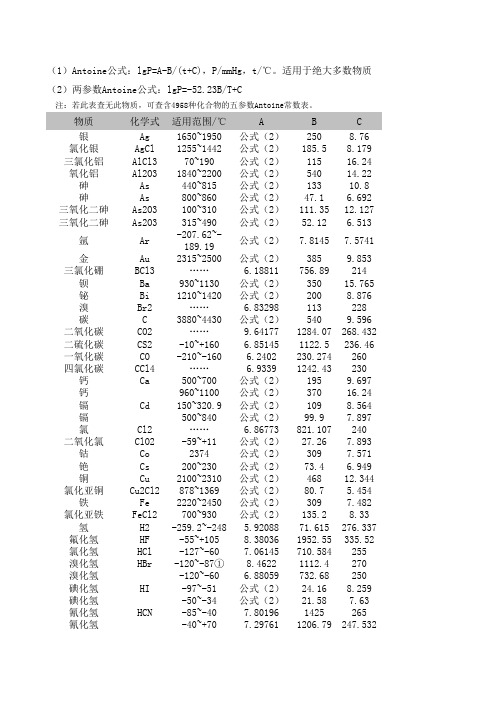
(1)Antoine公式:lgP=A-B/(t+C),P/mmHg,t/℃。
适用于绝大多数物质(2)两参数Antoine公式:lgP=-52.23B/T+C注:若此表查无此物质,可查含4958种化合物的五参数Antoine常数表。
物质化学式适用范围/℃A B C银Ag1650~1950公式(2)2508.76氯化银AgCl1255~1442公式(2)185.58.179三氯化铝AlCl370~190公式(2)11516.24氧化铝Al2O31840~2200公式(2)54014.22砷As440~815公式(2)13310.8砷As800~860公式(2)47.1 6.692三氧化二砷As2O3100~310公式(2)111.3512.127三氧化二砷As2O3315~490公式(2)52.12 6.513氩Ar-207.62~-189.19公式(2)7.81457.5741金Au2315~2500公式(2)3859.853三氯化硼BCl3…… 6.18811756.89214钡Ba930~1130公式(2)35015.765铋Bi1210~1420公式(2)2008.876溴Br2…… 6.83298113228碳C3880~4430公式(2)5409.596二氧化碳CO2……9.641771284.07268.432二硫化碳CS2-10~+160 6.851451122.5236.46一氧化碳CO-210~-160 6.2402230.274260四氯化碳CCl4…… 6.93391242.43230钙Ca500~700公式(2)1959.697钙960~1100公式(2)37016.24镉Cd150~320.9公式(2)1098.564镉500~840公式(2)99.97.897氯Cl2…… 6.86773821.107240二氧化氯ClO2-59~+11公式(2)27.267.893钴Co2374公式(2)3097.571铯Cs200~230公式(2)73.4 6.949铜Cu2100~2310公式(2)46812.344氯化亚铜Cu2Cl2878~1369公式(2)80.7 5.454铁Fe2220~2450公式(2)3097.482氯化亚铁FeCl2700~930公式(2)135.28.33氢H2-259.2~-248 5.9208871.615276.337氟化氢HF-55~+1058.380361952.55335.52氯化氢HCl-127~-607.06145710.584255溴化氢HBr-120~-87①8.46221112.4270溴化氢-120~-60 6.88059732.68250碘化氢HI-97~-51公式(2)24.168.259碘化氢-50~-34公式(2)21.587.63氰化氢HCN-85~-407.801961425265氰化氢-40~+707.297611206.79247.532过氧化氢H2O210~90公式(2)48.538.853水②H2O0~608.107651750.286235水③60~1507.966811668.21228硒化氢H2Se66~-26公式(2)20.217.431硫化氢H2S-110~83公式(2)20.697.88碲化氢H2Te-46~0公式(2)22.767.26氦He……16.1313282.126290汞Hg100~2007.469051771.898244.831汞200~3007.73243003.68262.482汞300~4007.690592958.841258.46汞400~8007.75313068.195273.438氯化汞HgCl260~130公式(2)85.0310.888氯化汞130~270公式(2)78.8510.094氯化汞HgCl2275~309公式(2)61.028.409氯化亚汞Hg2Cl2…8.521513110.96168碘I2…7.263041697.87204钾K260~760公式(2)84.97.183氟化钾KF1278~1500公式(2)207.59氯化钾KCl690~1105公式(2)174.58.3526氯化钾1116~1418公式(2)169.78.13溴化钾KBr906~1063公式(2)168.18.247溴化钾1095~1375公式(2)163.87.936碘化钾KI843~1028公式(2)157.68.0957碘化钾1063~1333公式(2)155.77.949氢氧化钾KOH1170~1327公式(2)1367.33氪Kr-188.7~-169公式(2)10.0657.177氟化锂LiF1398~1666公式(2)218.48.753镁Mg900~1070公式(2)26012.993锰Mn1510~1900公式(2)2679.3钼Mo 1800~2240公式(2)68010.844氮N2-210~-180 6.86606308.365273.2一氧化氮NO-200~161公式(2)16.42310.084一氧化氮-163.7~148公式(2)13.048.44三氧化二氮N2O3-25~0公式(2)39.410.3四氧化二氮N2O4-100~-40公式(2)55.1613.4四氧化二氮-40~-10公式(2)45.4411.214五氧化二氮N2O5-30~+30公式(2)57.1812.647氯化亚硝酰NOCl-61.5~-5.4公式(2)25.57.87肼N2H4-10~+398.26231881.6238肼39~2507.773061620218钠Na180~883公式(2)103.37.553氯化钠NaF1562~1701公式(2)218.28.64氯化钠NaCl976~1155公式(2)180.38.3297氯化钠1562~1430公式(2)185.88.548溴化钠NaBr1138~1394公式(2)161.6 4.948碘化钠NaI1063~1307公式(2)165.18.371氰化钠NaCN800~1360公式(2)155.527.472氢氧化钠NaOH1010~1402公式(2)1327.03氖Ne……7.57352183.34285镍Ni2360公式(2)3097.6四羰基镍Ni(CO) 42~40公式(2)29.87.78氧O2-210~-160 6.98983370.757273.2臭氧O3…… 6.72602566.95260磷(白磷)P20~44.1公式(2)63.1239.6511磷(紫磷)P380~590公式(2)108.5111.0842磷化氢PH3…… 6.70101643.72256铅Pb525~1325公式(2)188.57.827氯化铅PbCl2500~950公式(2)141.98.961铂Pt1425~1765公式(2)4867.786铷Rb250~370公式(2)76 6.976氡Rn…… 6.6964717.986250硫S…… 6.695352285.37155二氧化硫SO2……7.327761022.8240三氧化硫SO324~48公式(2)43.4510.022锑Sb1070~1325公式(2)1899.051三氯化锑SbCl3170~253公式(2)49.448.09硒Se…… 6.961583256.55110二氧化硒SeO2…… 6.577811879.81179硅Si1200~1320公式(2)170 5.95四氯化硅SiCl4-70~+5公式(2)30.17.644甲硅烷SiH4-160~112公式(2)12.69 6.996二氧化硅SiO21860~2230公式(2)50613.43锡Sn1950~2270公式(2)3289.643四氯化锡SnCl4-52~-38公式(2)46.749.824锶 Sr940~1140公式(2)36016.056铊Tl950~1200公式(2)120 6.14钨W2230~2770公式(2)8979.92氙Ke…… 6.6788573.48260锌Zn250~419.4公式(2)1339.2甲烷XH4固体③7.6954532.2275甲烷液体 6.61184339.93266氯甲烷CH3Cl-47~-10公式(2)21.9887.481三氯甲烷CHCl3-30~+150 6.903281163.03227.4二苯基甲烷C13H12217~283公式(2)52.367.967氯溴甲烷CH2ClBr-10~+155 6.927761165.59220硝基甲烷CH3O2N47~100公式(2)39.9148.033乙烷C2HS…… 6.80266656.4256氯乙烷C2H5Cl65~+70 6.8027949.62230溴乙烷C2H5Br-50~+130 6.892851083.8231.7均二氯乙烷C2H4Cl2……7.184311358.46232.2均二溴乙烷C2H4Br2……7.062451469.7220.1环氧乙烷C2H4O-70~+1007.407831181.31250.6偏二氯乙烷C2H2Cl20~30公式(2)31.7067.909 1,1,2一三氯乙烷C2H3Cl3…… 6.851891262.57205.17丙烷C3H8…… 6.82973813.2248正氯丙烷C3H7Cl0~50公式(2)28.8947.593环氧丙烷(1,2)C3H6O-35~+1307.064921113.6232正丁烷C4H10…… 6.83029945.9240异丁烷C4H10…… 6.74808882.8240正戊烷C5H12…… 6.852211064.63232异戊烷C5H12…… 6.789671020.012233.097环戊烷C5H10…… 6.886761124.162231.361正己烷C6H14…… 6.877761171.53224.366环已烷④C6H12-50~200 6.844981203.526222.863正庚烷C7H16…… 6.90241268.115216.9正辛烷C8H18-20~+407.3721587.81230.07正辛烷20~200 6.923741355.126209.517异辛烷(2-甲基庚烷)C8H18…… 6.917351337.468213.963正壬烷C9H20-10~+607.26431607.12217.54正壬烷60~230 6.935131428.811201.619正癸烷C10H2210~807.315091705.6212.59正癸烷70~260 6.953671501.268194.48正十一烷C11H2415~1007.36851803.9208.32正十一烷100~310 6.976741566.65187.48正十二烷C12H265~1207.355181867.55202.59正十二烷115~320 6.980591625.928180.311正十三烷C13H2815~1327.5362016.19203.02正十三烷132~330 6.98871677.43172.9正十四烷C14H3015~1457.61332133.75200.8正十四烷145~340 6.99571725.46165.75正十五烷C15H3215~1607.69912242.42198.72正十五烷160~3507.00171768.42158.49正十六烷C16H34……7.030441831.317154.528正十七烷C17H3620~1907.83692440.2194.59正十七烷190~3207.01151847.12145.52正十八烷C18H3820~2007.91172542193.4正十八烷200~3507.01561883.73139.46正十九烷C19H4020~408.72623041.1207.3正十九烷160~4107.01921916.96131.66正二十烷C20H4225~2238.76033113204.07正二十烷223~4207.02251948.7127.8乙烯C2H4…… 6.74756585255氯乙烯C2H3 Cl-11~+50 6.49712783.4230 1,1,2一三氯乙烯C2HCl3……7.028081315.04230苯乙烯C8H8…… 6.924091420206丙烯C3H6…… 6.8196785247丁稀-1C4H8…… 6.8429926.1240顺-2-丁烯C4H8…… 6.86926960.1237反-2-丁稀C4H8…… 6.86952960.8240 2-甲基丙烯-1C4H8…… 6.84134923.2240 1,2一丁二烯C4H6-60~+807.16191121251 1,3一丁二烯C4H6-80~+65 6.85941935.531239.5542-甲基丁二稀-1,3C5H8-50~+95 6.903341080.966234.668乙炔C2H2-140~-82公式(2)21.9148.933甲醇CH4O-20~+1407.878631473.11230苯甲醇C7H8O20~1137.818441950.3194.36苯甲醇113~300 6.959161461.64153乙醇C2H6O……8.044941554.3222.65正丙醇C3H8O……7.997331569.7209.5异丙醇C3H8O0~113 6.6604813.055132.93正丁醇C4H1075~117.5公式(2)46.7749.1362特丁醇C4H10……8.135961582.4218.9乙二醇C2H6O225~1128.26212197212乙二醇112~3407.88081957193.8乙醛C2H4 O-75~-457.38391216.8250乙醛-45~+70 6.81089992230丙酮C3H6O……7.024*********二乙基酮C5H10O…… 6.857911216.3204甲乙酮C4H3O…… 6.974211209.6216甲酸CH2O2…… 6.944591295.26218苯甲酸C7H6O260~110公式(2)63.829.033乙酸C2H4O20~367.803071651.2225乙酸36~1707.188071416.7211丙酸C3H6O20~607.715531690210丙酸60~1857.350271497.775194.12正丁酸C4H8O20~827.859411800.7200正丁酸82~2107.384231542.6179月硅酸C12H24O2164~205公式(2)74.3869.768十四烷酸C14H28O2190~224公式(2)75.7839.541乙酐C4H6O3100~140公式(2)45.5858.688顺丁烯二酸酐C4H2O360~160公式(2)46.347.825邻苯二甲酸酐C3H4O3160~285公式(2)54.928.022酷酸乙醋C4H8 O2-20~+1507.098081238.71217甲酸乙酯C3H6O2-30~+2357.1171176.6223.4醋酸甲酯C3H6O2……7.202111232.83228苯甲酸甲酯C8H8O225~1007.43121871.5213.9苯甲酸甲酯100~2607.078321656.2595.23甲酸甲酯C2H4O2……7.136231111229.2水杨酸甲酯C8H8O3175~215公式(2)48.678.008氨基甲酸乙酯C3H7O2N……7.421641758.21205甲醚C2H6O…… 6.73669791.184230苯甲醚C7H8O…… 6.989261453.6200二苯醚C12H10O25~147⑤7.45312115.2206.8二苯醚147~3257.098941871.92185.84甲乙醚C3H8O0~25公式(2)26.2627.769乙醚C4H10O…… 6.78574994.195210.2甲胺CH5N-93~-45 6.91831883.054223.122甲胺-45~+50 6.91205838.116224.267二甲胺C2H7N-80~-307.420611085.7233二甲胺-30~+657.185531008.4227.353三甲胺C3H9N-90~-407.011741014.2243.1三甲胺-60~+850 6.81628937.49235.35乙胺C2H7N-70~-207.091371019.7225乙胺-20~+907.05413987.31220二乙胺C4H11N-30~+100 6.831881057.2212三乙胺C6H15N0~130 6.82641161.4205苯胺C6H7N……7.241791675.3200二甲替甲酰胺C3H7ON15~607.34381624.7216.2二甲替酰胺60~350 6.996081437.84199.83二苯胺C12H11N278~284公式(2)57.358.008间硝基苯胺C6H6O2N2190~260公式(2)77.3459.5595邻硝基苯胺C6H5O2N2150~260公式(2)63.8818.8684对硝基苯胺C6H6O2N2190~260公式(2)77.3459.5595苯酚C6H6O……7.136171518.1175邻甲酚C7H8O…… 6.979431479.4170间甲酚C7H8O……7.623361907.24201对甲酚C7H8O……7.005921493160α-萘酚C10H8O……7.284212077.56184β-萘酚C10H8O……7.347142135183苯⑥C6H6…… 6.905651211.033220.79氯苯C6H5Cl0~427.10691500224氯苯42~230 6.945941413.12216邻二氯苯C6H4Cl2…… 6.9241538.3200乙苯C8H10…… 6.957191424.255213.206氟苯C6H5F-40~+180 6.936671736.35220硝基苯C6H6O2N112~209公式(2)48.9558.192甲苯C7H8…… 6.954641341.8219.482邻硝基甲苯C7H7O2N50~225公式(2)48.1147.9728间硝基甲苯C7H7O2N55~235公式(2)50.1288.0655对硝基甲苯C7H7O2N80~240公式(2)49.957.9815三硝基甲苯C7H5O6N3…… 3.86731259.406160邻二甲苯C8H10…… 6.998911474.679213.686间二甲苯C8H107.009081462.266215.105对二甲苯C8H10 6.990521453.43215.307乙酰苯C8H8O30~100公式(2)55.1179.1352乙腈C2H3N……7.119881314.4230丙烯腈C3H3N-20~+1407.038551232.53222.47氰C2N2-72~-28公式(2)32.4379.6539氰-36~-6公式(2)23.757.808萘C10H8…… 6.845771606.529187.227α-甲基綦C11H10……7.068991852.674197.716β-甲基萘C11H10……7.06851840.268198.395蓖C14H10100~160公式(2)728.91蓖223~342公式(2)59.2197.91蓖醌C14H3O2224~286公式(2)110.0512.305蓖醌285~370公式(2)63.9858.002樟脑C10H16O0~18公式(2)53.5598.799咔唑C12H9N244~352公式(2)64.7158.28芴C13H10161~300公式(2)56.6158.059呋喃C4H4O-35~+90 6.975331010.851227.74吗啉C4H9ON0~447.718131745.8235吗啉44~1707.16031447.7210菲C14H10203~347公式(2)57.2477.771喹啉C9H7N180~240公式(2)49.727.969噻吩C4H4S-10~180 6.959261246.038221.354草酸C2H2O455~105公式(2)90.502612.2229光气COCl2-68~+68 6.84297941.25230氨⑥NH3-83~+607.554661002.711247.885氯化铵NH4Cl100~400公式(2)83.48610.0164氰化铵NH4CN7~17公式(2)41.4819.978①固体②见第六章③三相点:-182.48℃,87.7毫米汞柱.④三相点6.67℃,39.96毫米汞柱.⑤过冷的.⑥三相点:5.525℃,35.856毫米汞柱.。
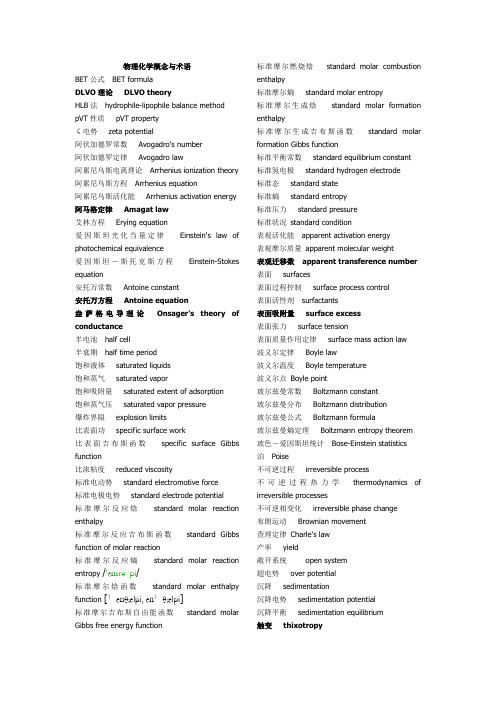
物理化学概念与术语BET公式BET formulaDLVO理论DLVO theoryHLB法hydrophile-lipophile balance method pVT性质pVT propertyζ电势zeta potential阿伏加德罗常数Avogadro's number阿伏加德罗定律Avogadro law阿累尼乌斯电离理论Arrhenius ionization theory 阿累尼乌斯方程Arrhenius equation阿累尼乌斯活化能Arrhenius activation energy 阿马格定律Amagat law艾林方程Erying equation爱因斯坦光化当量定律Einstein's law of photochemical equivalence爱因斯坦-斯托克斯方程Einstein-Stokes equation安托万常数Antoine constant安托万方程Antoine equation盎萨格电导理论Onsager's theory of conductance半电池half cell半衰期half time period饱和液体saturated liquids饱和蒸气saturated vapor饱和吸附量saturated extent of adsorption饱和蒸气压saturated vapor pressure爆炸界限explosion limits比表面功specific surface work比表面吉布斯函数specific surface Gibbs function比浓粘度reduced viscosity标准电动势standard electromotive force标准电极电势standard electrode potential标准摩尔反应焓standard molar reaction enthalpy标准摩尔反应吉布斯函数standard Gibbs function of molar reaction标准摩尔反应熵standard molar reaction entropy /'entrəpi/标准摩尔焓函数standard molar enthalpy function [ˈenθælpi, enˈθælpi]标准摩尔吉布斯自由能函数standard molar Gibbs free energy function 标准摩尔燃烧焓standard molar combustion enthalpy标准摩尔熵standard molar entropy标准摩尔生成焓standard molar formation enthalpy标准摩尔生成吉布斯函数standard molar formation Gibbs function标准平衡常数standard equilibrium constant标准氢电极standard hydrogen electrode标准态standard state标准熵standard entropy标准压力standard pressure标准状况standard condition表观活化能apparent activation energy表观摩尔质量apparent molecular weight表观迁移数apparent transference number 表面surfaces表面过程控制surface process control表面活性剂surfactants表面吸附量surface excess表面张力surface tension表面质量作用定律surface mass action law波义尔定律Boyle law波义尔温度Boyle temperature波义尔点Boyle point玻尔兹曼常数Boltzmann constant玻尔兹曼分布Boltzmann distribution玻尔兹曼公式Boltzmann formula玻尔兹曼熵定理Boltzmann entropy theorem 玻色-爱因斯坦统计Bose-Einstein statistics泊Poise不可逆过程irreversible process不可逆过程热力学thermodynamics of irreversible processes不可逆相变化irreversible phase change布朗运动Brownian movement查理定律Charle's law产率yield敞开系统open system超电势over potential沉降sedimentation沉降电势sedimentation potential沉降平衡sedimentation equilibrium触变thixotropy粗分散系统thick disperse system催化剂catalyst单分子层吸附理论mono molecule layer adsorption单分子反应unimolecular reaction单链反应straight chain reactions弹式量热计bomb calorimeter道尔顿定律Dalton law道尔顿分压定律Dalton partial pressure law德拜和法尔肯哈根效应Debye and Falkenhagen effect德拜立方公式Debye cubic formula德拜-休克尔极限公式Debye-Huckel's limiting equation等焓过程isenthalpic process等焓线isenthalpic line等几率定理theorem of equal probability等温等容位Helmholtz free energy等温等压位Gibbs free energy等温方程equation at constant temperature低共熔点eutectic point低共熔混合物eutectic mixture低会溶点lower consolute point低熔冰盐合晶cryohydric第二类永动机perpetual machine of the second kind第三定律熵third-law entropy第一类永动机perpetual machine of the first kind缔合化学吸附association chemical adsorption 电池常数cell constant电池电动势electromotive force of cells电池反应cell reaction电导conductance电导率conductivity电动势的温度系数temperature coefficient of electromotive force电动电势zeta potential电动现象electrokinetic phenomena电功electric work电化学electrochemistry电化学极化electrochemical polarization电极电势electrode potential电极反应reactions on the electrode 电极种类type of electrodes电解池electrolytic cell电量计coulometer电流效率current efficiency电迁移electro migration电迁移率electromobility电渗electroosmosis电渗析electrodialysis电泳electrophoresis丁达尔效应Dyndall effect定容摩尔热容molar heat capacity under constant volume定容温度计Constant volume thermometer定压摩尔热容molar heat capacity under constant pressure定压温度计constant pressure thermometer定域子系统localized particle system动力学方程kinetic equations动力学控制kinetics control独立子系统independent particle system对比摩尔体积reduced mole volume对比体积reduced volume对比温度reduced temperature对比压力reduced pressure对称数symmetry number对行反应reversible reactions对应状态原理principle of corresponding state 多方过程polytropic process多分子层吸附理论adsorption theory of multi-molecular layers二级反应second order reaction二级相变second order phase change法拉第常数faraday constant法拉第定律Faraday's law法扬思-帕尼思规则Fajans- Pancth's rule反电动势back E.M.F.反渗透reverse osmosis反应分子数molecularity反应级数reaction orders反应进度extent of reaction反应热heat of reaction反应速率rate of reaction反应速率常数constant of reaction rate范德华常数van der Waals constant范德华方程van der Waals equation范德华力van der Waals force范德华气体van der Waals gases范特霍夫方程van't Hoff equation范特霍夫规则van't Hoff rule范特霍夫渗透压公式van't Hoff equation of osmotic pressure非基元反应non-elementary reactions非体积功non-volume work非依时计量学反应time independent stoichiometric reactions菲克扩散第一定律Fick's first law of diffusion 沸点boiling point沸点升高elevation of boiling point费米-狄拉克统计Fermi-Dirac statistics分布distribution分布数distribution numbers分解电压decomposition voltage分配定律distribution law分散系统disperse system分散相dispersion phase分体积partial volume分体积定律partial volume law分压partial pressure分压定律partial pressure law分子反应力学mechanics of molecular reactions分子间力intermolecular force分子蒸馏molecular distillation封闭系统closed system附加压力excess pressure弗罗因德利希吸附经验式Freundlich empirical formula of adsorption负极negative pole负吸附negative adsorption复合反应composite reaction盖·吕萨克定律Gay-Lussac law盖斯定律Hess law甘汞电极calomel electrode感胶离子序lyotropic series杠杆规则lever rule高分子溶液macromolecular solution高会溶点upper consolute point隔离法the isolation method 格罗塞斯-德雷珀定律Grotthus-Draoer's law 隔离系统isolated system根均方速率root-mean-square speed功work功函work content共轭溶液conjugate solution共沸温度azeotropic temperature构型熵configurational entropy孤立系统isolated system固溶胶solid sol固态混合物solid solution固相线solid phase line光反应photoreaction光化学第二定律the second law of actinochemistry光化学第一定律the first law of actinochemistry光敏反应photosensitized reactions光谱熵spectrum entropy广度性质extensive property广延量extensive quantity广延性质extensive property规定熵stipulated entropy过饱和溶液oversaturated solution过饱和蒸气oversaturated vapor过程process过渡状态理论transition state theory过冷水super-cooled water过冷液体overcooled liquid过热液体overheated liquid亥姆霍兹函数Helmholtz function亥姆霍兹函数判据Helmholtz function criterion 亥姆霍兹自由能Helmholtz free energy亥氏函数Helmholtz function焓enthalpy亨利常数Henry constant亨利定律Henry law恒沸混合物constant boiling mixture恒容摩尔热容molar heat capacity at constant volume恒容热heat at constant volume恒外压constant external pressure恒压摩尔热容molar heat capacity at constant pressure恒压热heat at constant pressure化学动力学chemical kinetics化学反应计量式stoichiometric equation of chemical reaction化学反应计量系数stoichiometric coefficient of chemical reaction化学反应进度extent of chemical reaction化学亲合势chemical affinity化学热力学chemical thermodynamics化学势chemical potential化学势判据chemical potential criterion化学吸附chemisorptions环境environment环境熵变entropy change in environment挥发度volatility混合熵entropy of mixing混合物mixture活度activity活化控制activation control活化络合物理论activated complex theory活化能activation energy霍根-华森图Hougen-Watson Chart基态能级energy level at ground state基希霍夫公式Kirchhoff formula基元反应elementary reactions积分溶解热integration heat of dissolution吉布斯-杜亥姆方程Gibbs-Duhem equation吉布斯-亥姆霍兹方程Gibbs-Helmhotz equation吉布斯函数Gibbs function吉布斯函数判据Gibbs function criterion吉布斯吸附公式Gibbs adsorption formula吉布斯自由能Gibbs free energy吉氏函数Gibbs function极化电极电势polarization potential of electrode极化曲线polarization curves极化作用polarization极限摩尔电导率limiting molar conductivity几率因子steric factor(空间位阻因数,空间因子) 计量式stoichiometric equation计量系数stoichiometric coefficient价数规则rule of valence简并度degeneracy 键焓bond enthalpy胶冻broth jelly胶核colloidal nucleus胶凝作用demulsification胶束micelle胶体colloid胶体分散系统dispersion system of colloid胶体化学collochemistry胶体粒子colloidal particles胶团micelle焦耳Joule焦耳-汤姆生实验Joule-Thomson experiment焦耳-汤姆生系数Joule-Thomson coefficient焦耳-汤姆生效应Joule-Thomson effect焦耳定律Joule's law接触电势contact potential接触角contact angle节流过程throttling process节流膨胀throttling expansion节流膨胀系数coefficient of throttling expansion结线tie line结晶热heat of crystallization解离化学吸附dissociation chemical adsorption 界面interfaces界面张力surface tension浸湿immersion wetting浸湿功immersion wetting work精馏rectify聚(合)电解质polyelectrolyte聚沉coagulation聚沉值coagulation value绝对反应速率理论absolute reaction rate theory绝对熵absolute entropy绝对温标absolute temperature scale绝热过程adiabatic process绝热量热计adiabatic calorimeter绝热指数adiabatic index卡诺定理Carnot theorem卡诺循环Carnot cycle开尔文公式Kelvin formula柯诺瓦洛夫-吉布斯定律Konovalov-Gibbs law 科尔劳施离子独立运动定律Kohlrausch's Lawof Independent Migration of Ions可能的电解质potential electrolyte可逆电池reversible cell可逆过程reversible process可逆过程方程reversible process equation可逆体积功reversible volume work可逆相变reversible phase change克拉佩龙方程Clapeyron equation克劳修斯不等式Clausius inequality克劳修斯-克拉佩龙方程Clausius-Clapeyron equation控制步骤control step库仑计coulometer扩散控制diffusion controlled拉普拉斯方程Laplace's equation拉乌尔定律Raoult law兰格缪尔-欣谢尔伍德机理Langmuir-Hinshelwood mechanism兰格缪尔吸附等温式Langmuir adsorption isotherm formula雷利公式Rayleigh equation冷冻系数coefficient of refrigeration冷却曲线cooling curve离解热heat of dissociation离解压力dissociation pressure离域子系统non-localized particle systems离子的标准摩尔生成焓standard molar formation of ion离子的电迁移率mobility of ions离子的迁移数transport number of ions离子独立运动定律law of the independent migration of ions离子氛ionic atmosphere离子强度ionic strength理想混合物perfect mixture理想气体ideal gas理想气体的绝热指数adiabatic index of ideal gases理想气体的微观模型micro-model of ideal gas 理想气体反应的等温方程isothermal equation of ideal gaseous reactions理想气体绝热可逆过程方程adiabatic reversible process equation of ideal gases理想气体状态方程state equation of ideal gas 理想溶液ideal solutions理想稀溶液ideal dilute solution理想液态混合物perfect liquid mixture粒子particles粒子的配分函数partition function of particles 连串反应consecutive reactions链的传递物chain carrier链反应chain reactions量热熵calorimetric entropy量子统计quantum statistics量子效率quantum yield临界参数critical parameter临界常数critical constant临界点critical point临界胶束浓度critical micelle concentration临界摩尔体积critical molar volume临界温度critical temperature临界压力critical pressure临界状态critical state零级反应zero order reaction流动电势streaming potential流动功flow work笼罩效应cage effect路易斯-兰德尔逸度规则Lewis-Randall rule of fugacity露点dew point露点线dew point line麦克斯韦关系式Maxwell relations麦克斯韦速率分布Maxwell distribution of speeds麦克斯韦能量分布Maxwell distribution of energy 毛细管凝结condensation in capillary毛细现象capillary phenomena米凯利斯常数Michaelis constant摩尔电导率molar conductivity摩尔反应焓molar reaction enthalpy摩尔混合熵mole entropy of mixing摩尔气体常数molar gas constant摩尔热容molar heat capacity摩尔溶解焓mole dissolution enthalpy摩尔稀释焓mole dilution enthalpy内扩散控制internal diffusions control内能internal energy内压力internal pressure能级energy levels能级分布energy level distribution能量均分原理principle of the equipartition of energy能斯特方程Nernst equation能斯特热定理Nernst heat theorem凝固点freezing point凝固点降低lowering of freezing point凝固点曲线freezing point curve凝胶gelatin凝聚态condensed state凝聚相condensed phase浓差超电势concentration over-potential浓差极化concentration polarization浓差电池concentration cells帕斯卡pascal泡点bubble point泡点线bubble point line配分函数partition function配分函数的析因子性质property that partition function to be expressed as a product of the separate partition functions for each kind of state 碰撞截面collision cross section碰撞数the number of collisions偏摩尔量partial mole quantities平衡常数(理想气体反应)equilibrium constants for reactions of ideal gases平动配分函数partition function of translation 平衡分布equilibrium distribution平衡态equilibrium state平衡态近似法equilibrium state approximation 平衡状态图equilibrium state diagram平均活度mean activity平均活度系统mean activity coefficient平均摩尔热容mean molar heat capacity平均质量摩尔浓度mean mass molarity平均自由程mean free path平行反应parallel reactions破乳demulsification铺展spreading普遍化范德华方程universal van der Waals equation其它功the other work气化热heat of vaporization 气溶胶aerosol气体常数gas constant气体分子运动论kinetic theory of gases气体分子运动论的基本方程foundamental equation of kinetic theory of gases气溶胶aerosol气相线vapor line迁移数transport number潜热latent heat强度量intensive quantity强度性质intensive property亲液溶胶hydrophilic sol氢电极hydrogen electrodes区域熔化zone melting热heat热爆炸heat explosion热泵heat pump热功当量mechanical equivalent of heat热函heat content热化学thermochemistry热化学方程thermochemical equation热机heat engine热机效率efficiency of heat engine热力学thermodynamics热力学第二定律the second law of thermodynamics热力学第三定律the third law of thermodynamics热力学第一定律the first law of thermodynamics热力学基本方程fundamental equation of thermodynamics热力学几率thermodynamic probability热力学能thermodynamic energy热力学特性函数characteristic thermodynamic function热力学温标thermodynamic scale of temperature热力学温度thermodynamic temperature热熵thermal entropy热效应heat effect熔点曲线melting point curve熔化热heat of fusion溶胶colloidal sol溶解焓dissolution enthalpy溶液solution溶胀swelling乳化剂emulsifier乳状液emulsion润湿wetting润湿角wetting angle萨克尔-泰特洛德方程Sackur-Tetrode equation三相点triple point三相平衡线triple-phase line熵entropy熵判据entropy criterion熵增原理principle of entropy increase渗透压osmotic pressure渗析法dialytic process生成反应formation reaction升华热heat of sublimation实际气体real gas舒尔采-哈迪规则Schulze-Hardy rule松驰力relaxation force松驰时间time of relaxation速度常数reaction rate constant速率方程rate equations速率控制步骤rate determining step塔费尔公式Tafel equation态-态反应state-state reactions唐南平衡Donnan equilibrium淌度mobility特鲁顿规则Trouton rule特性粘度intrinsic viscosity体积功volume work统计权重statistical weight统计热力学statistic thermodynamics统计熵statistic entropy途径path途径函数path function外扩散控制external diffusion control完美晶体perfect crystalline完全气体perfect gas微观状态microstate微态microstate韦斯顿标准电池Weston standard battery维恩效应Wien effect 维里方程virial equation维里系数virial coefficient稳流过程steady flow process稳态近似法stationary state approximation无热溶液athermal solution无限稀溶液solutions in the limit of extreme dilution物理化学Physical Chemistry物理吸附physisorptions吸附adsorption吸附等量线adsorption isostere吸附等温线adsorption isotherm吸附等压线adsorption isobar吸附剂adsorbent吸附量extent of adsorption吸附热heat of adsorption吸附质adsorbate析出电势evolution or deposition potential析因子性质property that partition function to be expressed as a product of the separate partition functions for each kind of state稀溶液的依数性colligative properties of dilute solutions稀释焓dilution enthalpy系统system系统点system point系统的环境environment of system相phase相变phase change相变焓enthalpy of phase change相变化phase change相变热heat of phase change相点phase point相对挥发度relative volatility相对粘度relative viscosity相律phase rule相平衡热容heat capacity in phase equilibrium 相图phase diagram相倚子系统system of dependent particles悬浮液suspension循环过程cyclic process压力商pressure quotient压缩因子compressibility factor压缩因子图diagram of compressibility factor亚稳状态metastable state盐桥salt bridge盐析salting out阳极anode杨氏方程Young's equation液体接界电势liquid junction potential液相线liquid phase lines一级反应first order reaction一级相变first order phase change依时计量学反应time dependent stoichiometric reactions逸度fugacity逸度系数coefficient of fugacity阴极cathode荧光fluorescence永动机perpetual motion machine永久气体Permanent gas有效能available energy原电池primary cell原盐效应salt effect增比粘度specific viscosity憎液溶胶lyophobic sol沾湿adhesional wetting沾湿功the work of adhesional wetting折射率index of refraction真溶液true solution真实电解质real electrolyte真实气体real gas真实迁移数true transference number振动配分函数partition function of vibration振动特征温度characteristic temperature of vibration蒸气压下降depression of vapor pressure正常沸点normal point正吸附positive adsorption支链反应branched chain reactions直链反应straight chain reactions指前因子pre-exponential factor质量作用定律mass action law制冷系数coefficient of refrigeration中和热heat of neutralization轴功shaft work转动配分函数partition function of rotation转动特征温度characteristic temperature of vibration转化率convert ratio转化温度conversion temperature状态state状态方程state equation状态分布state distribution状态函数state function准静态过程quasi-static process准一级反应pseudo first order reaction自动催化作用auto-catalysis自发过程spontaneous process自由度degree of freedom自由度数number of degree of freedom自由焓free enthalpy自由能free energy自由膨胀free expansion组分数component number最低恒沸点lower azeotropic point最高恒沸点upper azeotropic point最佳反应温度optimal reaction temperature 最可几分布most probable distribution最可几速率most propable speed。
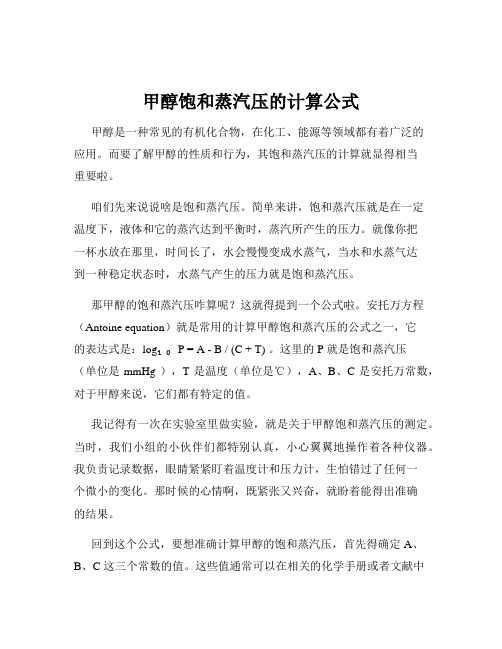
甲醇饱和蒸汽压的计算公式甲醇是一种常见的有机化合物,在化工、能源等领域都有着广泛的应用。
而要了解甲醇的性质和行为,其饱和蒸汽压的计算就显得相当重要啦。
咱们先来说说啥是饱和蒸汽压。
简单来讲,饱和蒸汽压就是在一定温度下,液体和它的蒸汽达到平衡时,蒸汽所产生的压力。
就像你把一杯水放在那里,时间长了,水会慢慢变成水蒸气,当水和水蒸气达到一种稳定状态时,水蒸气产生的压力就是饱和蒸汽压。
那甲醇的饱和蒸汽压咋算呢?这就得提到一个公式啦。
安托万方程(Antoine equation)就是常用的计算甲醇饱和蒸汽压的公式之一,它的表达式是:log₁₀ P = A - B / (C + T) 。
这里的 P 就是饱和蒸汽压(单位是 mmHg ),T 是温度(单位是℃),A、B、C 是安托万常数,对于甲醇来说,它们都有特定的值。
我记得有一次在实验室里做实验,就是关于甲醇饱和蒸汽压的测定。
当时,我们小组的小伙伴们都特别认真,小心翼翼地操作着各种仪器。
我负责记录数据,眼睛紧紧盯着温度计和压力计,生怕错过了任何一个微小的变化。
那时候的心情啊,既紧张又兴奋,就盼着能得出准确的结果。
回到这个公式,要想准确计算甲醇的饱和蒸汽压,首先得确定 A、B、C 这三个常数的值。
这些值通常可以在相关的化学手册或者文献中查到。
然后,把测量得到的温度值代入公式中,经过一番计算,就能得到对应的饱和蒸汽压啦。
不过,在实际应用中,还得考虑一些其他因素的影响。
比如说,甲醇的纯度啊,如果里面混有杂质,那计算结果可能就会有偏差。
还有实验环境的压力变化,也可能对结果产生影响。
总之,甲醇饱和蒸汽压的计算并不是一件特别复杂的事情,但需要我们认真对待每一个环节,准确获取数据,合理选择公式和参数,这样才能得到可靠的结果。
就像我们在生活中做任何事情一样,都得细心、用心,才能把事情做好,不是吗?希望大家以后在遇到和甲醇饱和蒸汽压相关的问题时,都能轻松应对,算出准确的结果!。
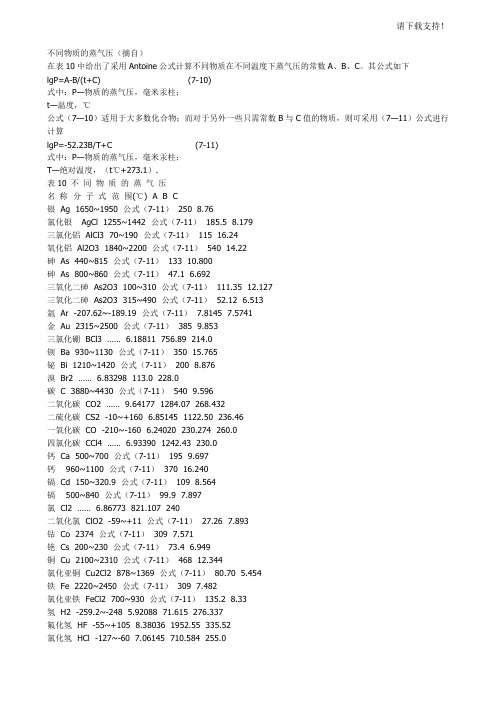
不同物质的蒸气压(摘自)在表10中给出了采用Antoine公式计算不同物质在不同温度下蒸气压的常数A、B、C。
其公式如下lgP=A-B/(t+C)(7-10)式中:P—物质的蒸气压,毫米汞柱;t—温度,℃公式(7—10)适用于大多数化合物;而对于另外一些只需常数B与C值的物质,则可采用(7—11)公式进行计算lgP=-52.23B/T+C (7-11)式中:P—物质的蒸气压,毫米汞柱;T—绝对温度,(t℃+273.1).表10 不同物质的蒸气压名称分子式范围(℃) A B C银 Ag 1650~1950 公式(7-11) 250 8.76氯化银 AgCl 1255~1442 公式(7-11) 185.5 8.179三氯化铝 AlCl3 70~190 公式(7-11) 115 16.24氧化铝 Al2O3 1840~2200 公式(7-11) 540 14.22砷 As 440~815 公式(7-11) 133 10.800砷 As 800~860 公式(7-11) 47.1 6.692三氧化二砷 As2O3 100~310 公式(7-11) 111.35 12.127三氧化二砷 As2O3 315~490 公式(7-11) 52.12 6.513氩 Ar -207.62~-189.19 公式(7-11) 7.8145 7.5741金 Au 2315~2500 公式(7-11) 385 9.853三氯化硼 BCl3 …… 6.18811 756.89 214.0钡 Ba 930~1130 公式(7-11) 350 15.765铋 Bi 1210~1420 公式(7-11) 200 8.876溴 Br2 …… 6.83298 113.0 228.0碳 C 3880~4430 公式(7-11) 540 9.596二氧化碳 CO2 …… 9.64177 1284.07 268.432二硫化碳 CS2 -10~+160 6.85145 1122.50 236.46一氧化碳 CO -210~-160 6.24020 230.274 260.0四氯化碳 CCl4 …… 6.93390 1242.43 230.0钙 Ca 500~700 公式(7-11) 195 9.697钙 960~1100 公式(7-11) 370 16.240镉 Cd 150~320.9 公式(7-11) 109 8.564镉 500~840 公式(7-11) 99.9 7.897氯 Cl2 …… 6.86773 821.107 240二氧化氯 ClO2 -59~+11 公式(7-11) 27.26 7.893钴 Co 2374 公式(7-11) 309 7.571铯 Cs 200~230 公式(7-11) 73.4 6.949铜 Cu 2100~2310 公式(7-11) 468 12.344氯化亚铜 Cu2Cl2 878~1369 公式(7-11) 80.70 5.454铁 Fe 2220~2450 公式(7-11) 309 7.482氯化亚铁 FeCl2 700~930 公式(7-11) 135.2 8.33氢 H2 -259.2~-248 5.92088 71.615 276.337氟化氢 HF -55~+105 8.38036 1952.55 335.52氯化氢 HCl -127~-60 7.06145 710.584 255.0溴化氢 HBr -120~-87① 8.4622 1112.4 270溴化氢 -120~-60 6.88059 732.68 250碘化氢 HI -97~-51 公式(7-11) 24.16 8.259碘化氢 -50~-34 公式(7-11) 21.58 7.630氰化氢 HCN -85~-40 7.80196 1425.0 265.0氰化氢 -40~+70 7.29761 1206.79 247.532过氧化氢 H2O2 10~90 公式(7-11) 48.53 8.853水② H2O 0~60 8.10765 1750.286 235.0水③ 60~150 7.96681 1668.21 228.0硒化氢 H2Se 66~-26 公式(7-11) 20.21 7.431硫化氢 H2S -110~83 公式(7-11) 20.69 7.880碲化氢 H2Te -46~0 公式(7-11) 22.76 7.260氦 He …… 16.1313 282.126 290汞 Hg 100~200 7.46905 1771.898 244.831汞 200~300 7.7324 3003.68 262.482汞 300~400 7.69059 2958.841 258.460汞 400~800 7.7531 3068.195 273.438氯化汞 HgCl2 60~130 公式(7-11) 85.03 10.888氯化汞 130~270 公式(7-11) 78.85 10.094氯化汞 HgCl2 275~309 公式(7-11) 61.02 8.409氯化亚汞 Hg2Cl2 … 8.52151 3110.96 168.0碘 I2 … 7.26304 1697.87 204.0钾 K 260~760 公式(7-11) 84.9 7.183氟化钾 KF 1278~1500 公式(7-11) 207.5 9.000氯化钾 KCl 690~1105 公式(7-11) 174.5 8.3526氯化钾 1116~1418 公式(7-11) 169.7 8.130溴化钾 KBr 906~1063 公式(7-11) 168.1 8.2470溴化钾 1095~1375 公式(7-11) 163.8 7.936碘化钾 KI 843~1028 公式(7-11) 157.6 8.0957碘化钾 1063~1333 公式(7-11) 155.7 7.949氢氧化钾 KOH 1170~1327 公式(7-11) 136 7.330氪 Kr -188.7~-169 公式(7-11) 10.065 7.1770氟化锂 LiF 1398~1666 公式(7-11) 218.4 8.753镁 Mg 900~1070 公式(7-11) 260 12.993锰 Mn 1510~1900 公式(7-11) 267 9.300钼 Mo 1800~2240 公式(7-11) 680 10.844氮 N2 -210~-180 6.86606 308.365 273.2一氧化氮 NO -200~161 公式(7-11) 16.423 10.084一氧化氮 -163.7~148 公式(7-11) 13.04 8.440三氧化二氮 N2O3 -25~0 公式(7-11) 39.4 10.30四氧化二氮 N2O4 -100~-40 公式(7-11) 55.16 13.40 四氧化二氮 -40~-10 公式(7-11) 45.44 11.214五氧化二氮 N2O5 -30~+30 公式(7-11) 57.18 12.647 氯化亚硝酰 NOCl -61.5~-5.4 公式(7-11) 25.5 7.870 肼 N2H4 -10~+39 8.26230 1881.6 238.0肼 39~250 7.77306 1620.0 218.0钠 Na 180~883 公式(7-11) 103.3 7.553氯化钠 NaF 1562~1701 公式(7-11) 218.2 8.640氯化钠 NaCl 976~1155 公式(7-11) 180.3 8.3297氯化钠 1562~1430 公式(7-11) 185.8 8.548溴化钠 NaBr 1138~1394 公式(7-11) 161.6 4.948碘化钠 NaI 1063~1307 公式(7-11) 165.1 8.371氰化钠 NaCN 800~1360 公式(7-11) 155.52 7.472氢氧化钠 NaOH 1010~1402 公式(7-11) 132 7.030氖 Ne …… 7.57352 183.34 285.0镍 Ni 2360 公式(7-11) 309 7.600四羰基镍 Ni(CO) 4 2~40 公式(7-11) 29.8 7.780氧 O2 -210~-160 6.98983 370.757 273.2臭氧 O3 …… 6.72602 566.95 260.0磷(白磷) P 20~44.1 公式(7-11) 63.123 9.6511磷(紫磷) P 380~590 公式(7-11) 108.51 11.0842磷化氢 PH3 …… 6.70101 643.72 256.0铅 Pb 525~1325 公式(7-11) 188.5 7.827氯化铅 PbCl2 500~950 公式(7-11) 141.9 8.961铂 Pt 1425~1765 公式(7-11) 486 7.786铷 Rb 250~370 公式(7-11) 76 6.976氡 Rn …… 6.6964 717.986 250硫 S …… 6.69535 2285.37 155.0二氧化硫 SO2 …… 7.32776 1022.80 240.0三氧化硫 SO3 24~48 公式(7-11) 43.45 10.022锑 Sb 1070~1325 公式(7-11) 189 9.051三氯化锑 SbCl3 170~253 公式(7-11) 49.44 8.090硒 Se …… 6.96158 3256.55 110.0二氧化硒 SeO2 …… 6.57781 1879.81 179.0硅 Si 1200~1320 公式(7-11) 170 5.950四氯化硅 SiCl4 -70~+5 公式(7-11) 30.1 7.644甲硅烷 SiH4 -160~112 公式(7-11) 12.69 6.996二氧化硅 SiO2 1860~2230 公式(7-11) 506 13.43锡 Sn 1950~2270 公式(7-11) 328 9.643四氯化锡 SnCl4 -52~-38 公式(7-11) 46.74 9.824锶 Sr 940~1140 公式(7-11) 360 16.056铊 Tl 950~1200 公式(7-11) 120 6.140钨 W 2230~2770 公式(7-11) 897 9.920氙 Ke …… 6.6788 573.480 260锌 Zn 250~419.4 公式(7-11) 133 9.200甲烷 XH4 固体③ 7.69540 532.20 275.00甲烷液体 6.61184 339.93 266.00氯甲烷 CH3Cl -47~-10 公式(7-11) 21.988 7.481三氯甲烷 CHCl3 -30~+150 6.90328 1163.03 227.4二苯基甲烷 C13H12 217~283 公式(7-11) 52.36 7.967 氯溴甲烷 CH2ClBr -10~+155 6.92776 1165.59 220.0硝基甲烷 CH3O2N 47~100 公式(7-11) 39.914 8.033乙烷 C2HS …… 6.80266 656.40 256.00氯乙烷 C2H5Cl 65~+70 6.80270 949.62 230溴乙烷 C2H5Br -50~+130 6.89285 1083.8 231.7均二氯乙烷 C2H4Cl2 …… 7.18431 1358.46 232.2均二溴乙烷 C2H4Br2 …… 7.06245 1469.70 220.1环氧乙烷 C2H4O -70~+100 7.40783 1181.31 250.60偏二氯乙烷 C2H2Cl2 0~30 公式(7-11) 31.706 7.9091,1,2一三氯乙烷 C2H3Cl3 …… 6.85189 1262.57 205.17丙烷 C3H8 …… 6.82973 813.20 248.00正氯丙烷 C3H7Cl 0~50 公式(7-11) 28.894 7.593环氧丙烷(1,2) C3H6O -35~+130 7.06492 1113.6 232正丁烷 C4H10 …… 6.83029 945.90 240.00异丁烷 C4H10 …… 6.74808 882.80 240.00正戊烷 C5H12 …… 6.85221 1064.63 232.000异戊烷 C5H12 …… 6.78967 1020.012 233.097环戊烷 C5H10 …… 6.88676 1124.162 231.361正己烷 C6H14 …… 6.87776 1171.530 224.366环已烷④ C6H12 -50~200 6.84498 1203.526 222.863正庚烷 C7H16 …… 6.90240 1268.115 216.900正辛烷 C8H18 -20~+40 7.37200 1587.81 230.07正辛烷 20~200 6.92374 1355.126 209.517异辛烷(2-甲基庚烷) C8H18 …… 6.91735 1337.468 213.963 正壬烷 C9H20 -10~+60 7.26430 1607.12 217.54正壬烷 60~230 6.93513 1428.811 201.619正癸烷 C10H22 10~80 7.31509 1705.60 212.59正癸烷 70~260 6.95367 1501.268 194.480正十一烷 C11H24 15~100 7.3685 1803.90 208.32正十一烷 100~310 6.97674 1566.65 187.48正十二烷 C12H26 5~120 7.35518 1867.55 202.59正十二烷 115~320 6.98059 1625.928 180.311正十三烷 C13H28 15~132 7.5360 2016.19 203.02正十三烷 132~330 6.9887 1677.43 172.90正十四烷 C14H30 15~145 7.6133 2133.75 200.8正十四烷 145~340 6.9957 1725.46 165.75正十五烷 C15H32 15~160 7.6991 2242.42 198.72正十五烷 160~350 7.0017 1768.42 158.49正十六烷 C16H34 …… 7.03044 1831.317 154.528正十七烷 C17H36 20~190 7.8369 2440.20 194.59正十七烷 190~320 7.0115 1847.12 145.52正十八烷 C18H38 20~200 7.9117 2542.00 193.4正十八烷 200~350 7.0156 1883.73 139.46正十九烷 C19H40 20~40 8.7262 3041.10 207.30正十九烷 160~410 7.0192 1916.96 131.66正二十烷 C20H42 25~223 8.7603 3113.0 204.07正二十烷 223~420 7.0225 1948.7 127.8乙烯 C2H4 …… 6.74756 585.00 255.00氯乙烯 C2H3 Cl -11~+50 6.49712 783.4 230.01,1,2一三氯乙烯 C2HCl3 …… 7.02808 1315.04 230.0苯乙烯 C8H8 …… 6.92409 1420.0 206丙烯 C3H6 …… 6.81960 785.0 247.00丁稀-1 C4H8 …… 6.84290 926.10 240.00顺-2-丁烯 C4H8 …… 6.86926 960.100 237.00反-2-丁稀 C4H8 …… 6.86952 960.80 240.002-甲基丙烯-1 C4H8 …… 6.84134 923.200 240.001,2一丁二烯 C4H6 -60~+80 7.1619 1121.0 251.001,3一丁二烯 C4H6 -80~+65 6.85941 935.531 239.5542-甲基丁二稀-1,3 C5H8 -50~+95 6.90334 1080.966 234.668 乙炔 C2H2 -140~-82 公式(7-11) 21.914 8.933甲醇 CH4O -20~+140 7.87863 1473.11 230.0苯甲醇 C7H8O 20~113 7.81844 1950.3 194.36苯甲醇 113~300 6.95916 1461.64 153.0乙醇 C2H6O …… 8.04494 1554.3 222.65正丙醇 C3H8O …… 7.99733 1569.70 209.5异丙醇 C3H8O 0~113 6.66040 813.055 132.93正丁醇 C4H10 75~117.5 公式(7-11) 46.774 9.1362特丁醇 C4H10 …… 8.13596 1582.4 218.9乙二醇 C2H6O2 25~112 8.2621 2197.0 212.0乙二醇 112~340 7.8808 1957.0 193.8乙醛 C2H4 O -75~-45 7.3839 1216.8 250乙醛 -45~+70 6.81089 992.0 230丙酮 C3H6O …… 7.02447 1161.0 224二乙基酮 C5H10O …… 6.85791 1216.3 204甲乙酮 C4H3O …… 6.97421 1209.6 216甲酸 CH2O2 …… 6.94459 1295.26 218.0苯甲酸 C7H6O2 60~110 公式(7-11) 63.82 9.033乙酸 C2H4O2 0~36 7.80307 1651.2 225乙酸 36~170 7.18807 1416.7 211丙酸 C3H6O2 0~60 7.71553 1690 210丙酸 60~185 7.35027 1497.775 194.12正丁酸 C4H8O2 0~82 7.85941 1800.7 200正丁酸 82~210 7.38423 1542.6 179月硅酸 C12H24O2 164~205 公式(7-11) 74.386 9.768十四烷酸 C14H28O2 190~224 公式(7-11) 75.783 9.541 乙酐 C4H6O3 100~140 公式(7-11) 45.585 8.688顺丁烯二酸酐 C4H2O3 60~160 公式(7-11) 46.34 7.825邻苯二甲酸酐 C3H4O3 160~285 公式(7-11) 54.92 8.022 酷酸乙醋 C4H8 O2 -20~+150 7.09808 1238.71 217.0甲酸乙酯 C3H6O2 -30~+235 7.11700 1176.6 223.4醋酸甲酯 C3H6O2 …… 7.20211 1232.83 228.0苯甲酸甲酯 C8H8O2 25~100 7.4312 1871.5 213.9苯甲酸甲酯 100~260 7.07832 1656.25 95.23甲酸甲酯 C2H4O2 …… 7.13623 1111.0 229.2水杨酸甲酯 C8H8O3 175~215 公式(7-11) 48.67 8.008氨基甲酸乙酯 C3H7O2N …… 7.42164 1758.21 205.0甲醚 C2H6O …… 6.73669 791.184 230.0苯甲醚 C7H8O …… 6.98926 1453.6 200二苯醚 C12H10O 25~147⑤ 7.4531 2115.2 206.8二苯醚 147~325 7.09894 1871.92 185.84甲乙醚 C3H8O 0~25 公式(7-11) 26.262 7.769乙醚 C4H10O …… 6.78574 994.195 210.2甲胺 CH5N -93~-45 6.91831 883.054 223.122甲胺 -45~+50 6.91205 838.116 224.267二甲胺 C2H7N -80~-30 7.42061 1085.7 233.0二甲胺 -30~+65 7.18553 1008.4 227.353三甲胺 C3H9N -90~-40 7.01174 1014.2 243.1三甲胺 -60~+850 6.81628 937.49 235.35乙胺 C2H7N -70~-20 7.09137 1019.7 225.0乙胺 -20~+90 7.05413 987.31 220.0二乙胺 C4H11N -30~+100 6.83188 1057.2 212.0三乙胺 C6H15N 0~130 6.8264 1161.4 205.0苯胺 C6H7N …… 7.24179 1675.3 200二甲替甲酰胺 C3H7ON 15~60 7.3438 1624.7 216.2二甲替酰胺 60~350 6.99608 1437.84 199.83二苯胺 C12H11N 278~284 公式(7-11) 57.35 8.008间硝基苯胺 C6H6O2N2 190~260 公式(7-11) 77.345 9.5595 邻硝基苯胺 C6H5O2N2 150~260 公式(7-11) 63.881 8.8684 对硝基苯胺 C6H6O2N2 190~260 公式(7-11) 77.345 9.5595 苯酚 C6H6O …… 7.13617 1518.1 175.0邻甲酚 C7H8O …… 6.97943 1479.4 170.0间甲酚 C7H8O …… 7.62336 1907.24 201.0对甲酚 C7H8O …… 7.00592 1493.0 160.0α-萘酚 C10H8O …… 7.28421 2077.56 184.0β-萘酚 C10H8O …… 7.34714 2135.00 183.0苯⑥ C6H6 …… 6.90565 1211.033 220.790氯苯 C6H5Cl 0~42 7.10690 1500.0 224.0氯苯 42~230 6.94594 1413.12 216.0邻二氯苯 C6H4Cl2 …… 6.92400 1538.3 200乙苯 C8H10 …… 6.95719 1424.255 213.206氟苯 C6H5F -40~+180 6.93667 1736.35 220.0硝基苯 C6H6O2N 112~209 公式(7-11) 48.955 8.192甲苯 C7H8 …… 6.95464 1341.800 219.482邻硝基甲苯 C7H7O2N 50~225 公式(7-11) 48.114 7.9728 间硝基甲苯 C7H7O2N 55~235 公式(7-11) 50.128 8.0655 对硝基甲苯 C7H7O2N 80~240 公式(7-11) 49.95 7.9815三硝基甲苯 C7H5O6N3 …… 3.8673 1259.406 160邻二甲苯 C8H10 …… 6.99891 1474.679 213.686间二甲苯 C8H10 7.00908 1462.266 215.105对二甲苯 C8H10 6.99052 1453.430 215.307乙酰苯 C8H8O 30~100 公式(7-11) 55.117 9.1352 乙腈 C2H3N …… 7.11988 1314.4 230丙烯腈 C3H3N -20~+140 7.03855 1232.53 222.47氰 C2N2 -72~-28 公式(7-11) 32.437 9.6539氰 C2N2 -36~-6 公式(7-11) 23.75 7.808萘 C10H8 …… 6.84577 1606.529 187.227α-甲基綦 C11H10 …… 7.06899 1852.674 197.716β-甲基萘 C11H10 …… 7.06850 1840.268 198.395蓖 C14H10 100~160 公式(7-11) 72 8.91蓖 223~342 公式(7-11) 59.219 7.910蓖醌 C14H3O2 224~286 公式(7-11) 110.05 12.305 蓖醌 285~370 公式(7-11) 63.985 8.002樟脑 C10H16O 0~18 公式(7-11) 53.559 8.799咔唑 C12H9N 244~352 公式(7-11) 64.715 8.280芴 C13H10 161~300 公式(7-11) 56.615 8.059呋喃 C4H4O -35~+90 6.97533 1010.851 227.740吗啉 C4H9ON 0~44 7.71813 1745.8 235.0吗啉 44~170 7.16030 1447.70 210.0菲 C14H10 203~347 公式(7-11) 57.247 7.771喹啉 C9H7N 180~240 公式(7-11) 49.72 7.969噻吩 C4H4S -10~180 6.95926 1246.038 221.354草酸 C2H2O4 55~105 公式(7-11) 90.5026 12.2229 光气 COCl2 -68~+68 6.84297 941.25 230氨⑥ NH3 -83~+60 7.55466 1002.711 247.885氯化铵 NH4Cl 100~400 公式(7-11) 83.486 10.0164 氰化铵 NH4CN 7~17 公式(7-11) 41.481 9.978①固体②见第六章③三相点:-182.48℃,87.7毫米汞柱.④三相点6.67℃,39.96毫米汞柱.⑤过冷的.⑥三相点:5.525℃,35.856毫米汞柱.。
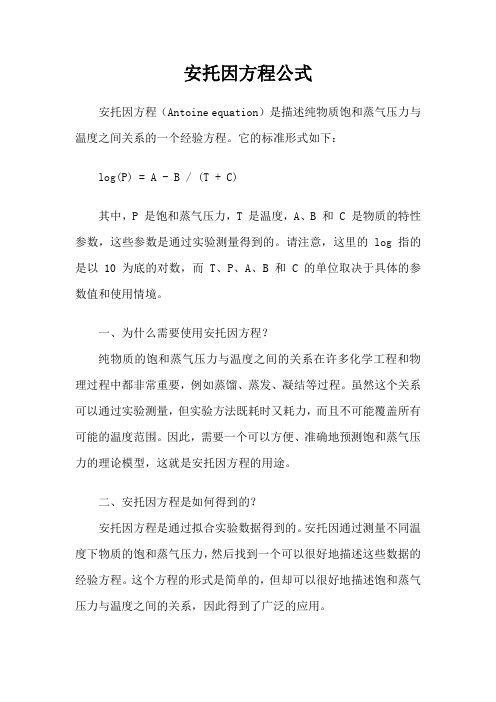
安托因方程公式
安托因方程(Antoine equation)是描述纯物质饱和蒸气压力与温度之间关系的一个经验方程。
它的标准形式如下:
log(P) = A - B / (T + C)
其中,P 是饱和蒸气压力,T 是温度,A、B 和 C 是物质的特性参数,这些参数是通过实验测量得到的。
请注意,这里的 log 指的是以 10 为底的对数,而 T、P、A、B 和 C 的单位取决于具体的参数值和使用情境。
一、为什么需要使用安托因方程?
纯物质的饱和蒸气压力与温度之间的关系在许多化学工程和物理过程中都非常重要,例如蒸馏、蒸发、凝结等过程。
虽然这个关系可以通过实验测量,但实验方法既耗时又耗力,而且不可能覆盖所有可能的温度范围。
因此,需要一个可以方便、准确地预测饱和蒸气压力的理论模型,这就是安托因方程的用途。
二、安托因方程是如何得到的?
安托因方程是通过拟合实验数据得到的。
安托因通过测量不同温度下物质的饱和蒸气压力,然后找到一个可以很好地描述这些数据的经验方程。
这个方程的形式是简单的,但却可以很好地描述饱和蒸气压力与温度之间的关系,因此得到了广泛的应用。
三、安托因方程有哪些局限性?
虽然安托因方程可以很好地描述饱和蒸气压力与温度之间的关系,但它也有一些局限性。
首先,它是一个经验方程,只适用于已经测量过的物质和温度范围。
如果要预测没有实验数据的物质或温度范围,安托因方程可能就不准确了。
其次,安托因方程假设饱和蒸气压力只依赖于温度,而实际上,饱和蒸气压力可能还会受到其他因素的影响,例如压力、物质的纯度等。
这些因素可能导致实际的饱和蒸气压力与安托因方程的预测值有所偏差。
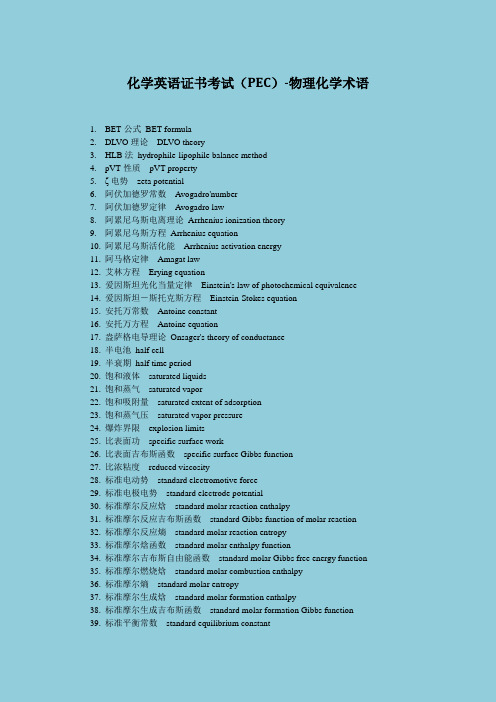
化学英语证书考试(PEC)-物理化学术语1.BET公式BET formula2.DLVO理论DLVO theory3.HLB法hydrophile-lipophile balance method4.pVT性质pVT property5.ζ电势zeta potential6.阿伏加德罗常数Avogadro'number7.阿伏加德罗定律Avogadro law8.阿累尼乌斯电离理论Arrhenius ionization theory9.阿累尼乌斯方程Arrhenius equation10.阿累尼乌斯活化能Arrhenius activation energy11.阿马格定律Amagat law12.艾林方程Erying equation13.爱因斯坦光化当量定律Einstein's law of photochemical equivalence14.爱因斯坦-斯托克斯方程Einstein-Stokes equation15.安托万常数Antoine constant16.安托万方程Antoine equation17.盎萨格电导理论Onsager's theory of conductance18.半电池half cell19.半衰期half time period20.饱和液体saturated liquids21.饱和蒸气saturated vapor22.饱和吸附量saturated extent of adsorption23.饱和蒸气压saturated vapor pressure24.爆炸界限explosion limits25.比表面功specific surface work26.比表面吉布斯函数specific surface Gibbs function27.比浓粘度reduced viscosity28.标准电动势standard electromotive force29.标准电极电势standard electrode potential30.标准摩尔反应焓standard molar reaction enthalpy31.标准摩尔反应吉布斯函数standard Gibbs function of molar reaction32.标准摩尔反应熵standard molar reaction entropy33.标准摩尔焓函数standard molar enthalpy function34.标准摩尔吉布斯自由能函数standard molar Gibbs free energy function35.标准摩尔燃烧焓standard molar combustion enthalpy36.标准摩尔熵standard molar entropy37.标准摩尔生成焓standard molar formation enthalpy38.标准摩尔生成吉布斯函数standard molar formation Gibbs function39.标准平衡常数standard equilibrium constant40.标准氢电极standard hydrogen electrode41.标准态standard state42.标准熵standard entropy43.标准压力standard pressure44.标准状况standard condition45.表观活化能apparent activation energy46.表观摩尔质量apparent molecular weight47.表观迁移数apparent transference number48.表面surfaces49.表面过程控制surface process control50.表面活性剂surfactants51.表面吸附量surface excess52.表面张力surface tension53.表面质量作用定律surface mass action law54.波义尔定律Boyle law55.波义尔温度Boyle temperature56.波义尔点Boyle point57.玻尔兹曼常数Boltzmann constant58.玻尔兹曼分布Boltzmann distribution59.玻尔兹曼公式Boltzmann formula60.玻尔兹曼熵定理Boltzmann entropy theorem61.玻色-爱因斯坦统计Bose-Einstein statistics62.泊Poise63.不可逆过程irreversible process64.不可逆过程热力学thermodynamics of irreversible processes65.不可逆相变化irreversible phase change66.布朗运动brownian movement67.查理定律Charle's law68.产率yield69.敞开系统open system70.超电势over potential71.沉降sedimentation72.沉降电势sedimentation potential73.沉降平衡sedimentation equilibrium74.触变thixotropy75.粗分散系统thick disperse system76.催化剂catalyst77.单分子层吸附理论mono molecule layer adsorption78.单分子反应unimolecular reaction79.单链反应straight chain reactions80.弹式量热计bomb calorimeter81.道尔顿定律Dalton law82.道尔顿分压定律Dalton partial pressure law83.德拜和法尔肯哈根效应Debye and Falkenhagen effect84.德拜立方公式Debye cubic formula85.德拜-休克尔极限公式Debye-Huckel's limiting equation86.等焓过程isenthalpic process87.等焓线isenthalpic line88.等几率定理theorem of equal probability89.等温等容位Helmholtz free energy90.等温等压位Gibbs free energy91.等温方程equation at constant temperature92.低共熔点eutectic point93.低共熔混合物eutectic mixture94.低会溶点lower consolute point95.低熔冰盐合晶cryohydric96.第二类永动机perpetual machine of the second kind97.第三定律熵third-law entropy98.第一类永动机perpetual machine of the first kind99.缔合化学吸附association chemical adsorption100.电池常数cell constant101.电池电动势electromotive force of cells102.电池反应cell reaction103.电导conductance104.电导率conductivity105.电动势的温度系数temperature coefficient of electromotive force 106.电动电势zeta potential107.电动现象electrokinetic phenomena108.电功electric work109.电化学electrochemistry110.电化学极化electrochemical polarization111.电极电势electrode potential112.电极反应reactions on the electrode113.电极种类type of electrodes114.电解池electrolytic cell115.电量计coulometer116.电流效率current efficiency117.电迁移electro migration118.电迁移率electromobility119.电渗electroosmosis120.电渗析electrodialysis121.电泳electrophoresis122.丁达尔效应Dyndall effect123.定容摩尔热容molar heat capacity under constant volume124.定容温度计Constant voIume thermometer125.定压摩尔热容molar heat capacity under constant pressure 126.定压温度计constant pressure thermometer127.定域子系统localized particle system128.动力学方程kinetic equations129.动力学控制kinetics control130.独立子系统independent particle system131.对比摩尔体积reduced mole volume132.对比体积reduced volume133.对比温度reduced temperature134.对比压力reduced pressure135.对称数symmetry number136.对行反应reversible reactions137.对应状态原理principle of corresponding state138.多方过程polytropic process139.多分子层吸附理论adsorption theory of multi-molecular layers 140.二级反应second order reaction141.二级相变second order phase change142.法拉第常数faraday constant143.法拉第定律Faraday's law144.法扬思-帕尼思规则Fajans- Pancth's rule145.反电动势back E.M.F.146.反渗透reverse osmosis147.反应分子数molecularity148.反应级数reaction orders149.反应进度extent of reaction150.反应热heat of reaction151.反应速率rate of reaction152.反应速率常数constant of reaction rate153.范德华常数van der Waals constant154.范德华方程van der Waals equation155.范德华力van der Waals force156.范德华气体van der Waals gases157.范特霍夫方程van't Hoff equation158.范特霍夫规则van't Hoff rule159.范特霍夫渗透压公式van't Hoff equation of osmotic pressure 160.非基元反应non-elementary reactions161.非体积功non-volume work162.非依时计量学反应time independent stoichiometric reactions 163.菲克扩散第一定律Fick's first law of diffusion164.沸点boiling point165.沸点升高elevation of boiling point166.费米-狄拉克统计Fermi-Dirac statistics167.分布distribution168.分布数distribution numbers169.分解电压decomposition voltage170.分配定律distribution law171.分散系统disperse system172.分散相dispersion phase173.分体积partial volume174.分体积定律partial volume law175.分压partial pressure176.分压定律partial pressure law177.分子反应力学mechanics of molecular reactions178.分子间力intermolecular force179.分子蒸馏molecular distillation180.封闭系统closed system181.附加压力excess pressure182.弗罗因德利希吸附经验式Freundlich empirical formula of adsorption 183.负极negative pole184.负吸附negative adsorption185.复合反应composite reaction186.盖·吕萨克定律Gay-Lussac law187.盖斯定律Hess law188.甘汞电极calomel electrode189.感胶离子序lyotropic series190.杠杆规则lever rule191.高分子溶液macromolecular solution192.高会溶点upper consolute point193.隔离法the isolation method194.格罗塞斯-德雷珀定律Grotthus-Draoer's law195.隔离系统isolated system196.根均方速率root-mean-square speed197.功work198.功函work content199.共轭溶液conjugate solution200.共沸温度azeotropic temperature201.构型熵configurational entropy202.孤立系统isolated system203.固溶胶solid sol204.固态混合物solid solution205.固相线solid phase line206.光反应photoreaction207.光化学第二定律the second law of actinochemistry208.光化学第一定律the first law of actinochemistry209.光敏反应photosensitized reactions210.光谱熵spectrum entropy211.广度性质extensive property212.广延量extensive quantity213.广延性质extensive property214.规定熵stipulated entropy215.过饱和溶液oversaturated solution216.过饱和蒸气oversaturated vapor217.过程process218.过渡状态理论transition state theory219.过冷水super-cooled water220.过冷液体overcooled liquid221.过热液体overheated liquid222.亥姆霍兹函数Helmholtz function223.亥姆霍兹函数判据Helmholtz function criterion224.亥姆霍兹自由能Helmholtz free energy225.亥氏函数Helmholtz function226.焓enthalpy227.亨利常数Henry constant228.亨利定律Henry law229.恒沸混合物constant boiling mixture230.恒容摩尔热容molar heat capacity at constant volume231.恒容热heat at constant volume232.恒外压constant external pressure233.恒压摩尔热容molar heat capacity at constant pressure234.恒压热heat at constant pressure235.化学动力学chemical kinetics236.化学反应计量式stoichiometric equation of chemical reaction 237.化学反应计量系数stoichiometric coefficient of chemical reaction 238.化学反应进度extent of chemical reaction239.化学亲合势chemical affinity240.化学热力学chemical thermodynamics241.化学势chemical potential242.化学势判据chemical potential criterion243.化学吸附chemisorptions244.环境environment245.环境熵变entropy change in environment246.挥发度volatility247.混合熵entropy of mixing248.混合物mixture249.活度activity250.活化控制activation control251.活化络合物理论activated complex theory252.活化能activation energy253.霍根-华森图Hougen-Watson Chart254.基态能级energy level at ground state255.基希霍夫公式Kirchhoff formula256.基元反应elementary reactions257.积分溶解热integration heat of dissolution258.吉布斯-杜亥姆方程Gibbs-Duhem equation259.吉布斯-亥姆霍兹方程Gibbs-Helmhotz equation260.吉布斯函数Gibbs function261.吉布斯函数判据Gibbs function criterion 262.吉布斯吸附公式Gibbs adsorption formula 263.吉布斯自由能Gibbs free energy264.吉氏函数Gibbs function265.极化电极电势polarization potential of electrode 266.极化曲线polarization curves267.极化作用polarization268.极限摩尔电导率limiting molar conductivity 269.几率因子steric factor270.计量式stoichiometric equation271.计量系数stoichiometric coefficient272.价数规则rule of valence273.简并度degeneracy274.键焓bond enthalpy275.胶冻broth jelly276.胶核colloidal nucleus277.胶凝作用demulsification278.胶束micelle279.胶体colloid280.胶体分散系统dispersion system of colloid 281.胶体化学collochemistry282.胶体粒子colloidal particles283.胶团micelle284.焦耳Joule285.焦耳-汤姆生实验Joule-Thomson experiment 286.焦耳-汤姆生系数Joule-Thomson coefficient 287.焦耳-汤姆生效应Joule-Thomson effect288.焦耳定律Joule's law289.接触电势contact potential290.接触角contact angle291.节流过程throttling process292.节流膨胀throttling expansion293.节流膨胀系数coefficient of throttling expansion 294.结线tie line295.结晶热heat of crystallization296.解离化学吸附dissociation chemical adsorption 297.界面interfaces298.界面张力surface tension299.浸湿immersion wetting300.浸湿功immersion wetting work301.精馏rectify302.聚(合)电解质polyelectrolyte303.聚沉coagulation304.聚沉值coagulation value305.绝对反应速率理论absolute reaction rate theory306.绝对熵absolute entropy307.绝对温标absolute temperature scale308.绝热过程adiabatic process309.绝热量热计adiabatic calorimeter310.绝热指数adiabatic index311.卡诺定理Carnot theorem312.卡诺循环Carnot cycle313.开尔文公式Kelvin formula314.柯诺瓦洛夫-吉布斯定律Konovalov-Gibbs law315.科尔劳施离子独立运动定律Kohlrausch's Law of Independent Migration of Ions 316.可能的电解质potential electrolyte317.可逆电池reversible cell318.可逆过程reversible process319.可逆过程方程reversible process equation320.可逆体积功reversible volume work321.可逆相变reversible phase change322.克拉佩龙方程Clapeyron equation323.克劳修斯不等式Clausius inequality324.克劳修斯-克拉佩龙方程Clausius-Clapeyron equation325.控制步骤control step326.库仑计coulometer327.扩散控制diffusion controlled328.拉普拉斯方程Laplace's equation329.拉乌尔定律Raoult law330.兰格缪尔-欣谢尔伍德机理Langmuir-Hinshelwood mechanism331.兰格缪尔吸附等温式Langmuir adsorption isotherm formula332.雷利公式Rayleigh equation333.冷冻系数coefficient of refrigeration334.冷却曲线cooling curve335.离解热heat of dissociation336.离解压力dissociation pressure337.离域子系统non-localized particle systems338.离子的标准摩尔生成焓standard molar formation of ion339.离子的电迁移率mobility of ions340.离子的迁移数transport number of ions341.离子独立运动定律law of the independent migration of ions342.离子氛ionic atmosphere343.离子强度ionic strength344.理想混合物perfect mixture345.理想气体ideal gas346.理想气体的绝热指数adiabatic index of ideal gases347.理想气体的微观模型micro-model of ideal gas348.理想气体反应的等温方程isothermal equation of ideal gaseous reactions 349.理想气体绝热可逆过程方程adiabatic reversible process equation of ideal gases 350.理想气体状态方程state equation of ideal gas351.理想稀溶液ideal dilute solution352.理想液态混合物perfect liquid mixture353.粒子particles354.粒子的配分函数partition function of particles355.连串反应consecutive reactions356.链的传递物chain carrier357.链反应chain reactions358.量热熵calorimetric entropy359.量子统计quantum statistics360.量子效率quantum yield361.临界参数critical parameter362.临界常数critical constant363.临界点critical point364.临界胶束浓度critical micelle concentration365.临界摩尔体积critical molar volume366.临界温度critical temperature367.临界压力critical pressure368.临界状态critical state369.零级反应zero order reaction370.流动电势streaming potential371.流动功flow work372.笼罩效应cage effect373.路易斯-兰德尔逸度规则Lewis-Randall rule of fugacity374.露点dew point375.露点线dew point line376.麦克斯韦关系式Maxwell relations377.麦克斯韦速率分布Maxwell distribution of speeds378.麦克斯韦能量分布MaxwelIdistribution of energy379.毛细管凝结condensation in capillary380.毛细现象capillary phenomena381.米凯利斯常数Michaelis constant382.摩尔电导率molar conductivity383.摩尔反应焓molar reaction enthalpy384.摩尔混合熵mole entropy of mixing385.摩尔气体常数molar gas constant386.摩尔热容molar heat capacity387.摩尔溶解焓mole dissolution enthalpy388.摩尔稀释焓mole dilution enthalpy389.内扩散控制internal diffusions control390.内能internal energy391.内压力internal pressure392.能级energy levels393.能级分布energy level distribution394.能量均分原理principle of the equipartition of energy395.能斯特方程Nernst equation396.能斯特热定理Nernst heat theorem397.凝固点freezing point398.凝固点降低lowering of freezing point399.凝固点曲线freezing point curve400.凝胶gelatin401.凝聚态condensed state402.凝聚相condensed phase403.浓差超电势concentration over-potential404.浓差极化concentration polarization405.浓差电池concentration cells406.帕斯卡pascal407.泡点bubble point408.泡点线bubble point line409.配分函数partition function410.配分函数的析因子性质property that partition function to be expressed as a product of the separate partition functions for each kind of state411.碰撞截面collision cross section412.碰撞数the number of collisions413.偏摩尔量partial mole quantities414.平衡常数(理想气体反应)equilibrium constants for reactions of ideal gases 415.平动配分函数partition function of translation416.平衡分布equilibrium distribution417.平衡态equilibrium state418.平衡态近似法equilibrium state approximation419.平衡状态图equilibrium state diagram420.平均活度mean activity421.平均活度系统mean activity coefficient422.平均摩尔热容mean molar heat capacity423.平均质量摩尔浓度mean mass molarity424.平均自由程mean free path425.平行反应parallel reactions426.破乳demulsification427.铺展spreading428.普遍化范德华方程universal van der Waals equation429.其它功the other work430.气化热heat of vaporization431.气溶胶aerosol432.气体常数gas constant433.气体分子运动论kinetic theory of gases434.气体分子运动论的基本方程foundamental equation of kinetic theory of gases435.气溶胶aerosol436.气相线vapor line437.迁移数transport number438.潜热latent heat439.强度量intensive quantity440.强度性质intensive property441.亲液溶胶hydrophilic sol442.氢电极hydrogen electrodes443.区域熔化zone melting444.热heat445.热爆炸heat explosion446.热泵heat pump447.热功当量mechanical equivalent of heat448.热函heat content449.热化学thermochemistry450.热化学方程thermochemical equation451.热机heat engine452.热机效率efficiency of heat engine453.热力学thermodynamics454.热力学第二定律the second law of thermodynamics 455.热力学第三定律the third law of thermodynamics456.热力学第一定律the first law of thermodynamics457.热力学基本方程fundamental equation of thermodynamics 458.热力学几率thermodynamic probability459.热力学能thermodynamic energy460.热力学特性函数characteristic thermodynamic function 461.热力学温标thermodynamic scale of temperature462.热力学温度thermodynamic temperature463.热熵thermal entropy464.热效应heat effect465.熔点曲线melting point curve466.熔化热heat of fusion467.溶胶colloidal sol468.溶解焓dissolution enthalpy469.溶液solution470.溶胀swelling471.乳化剂emulsifier472.乳状液emulsion473.润湿wetting474.润湿角wetting angle475.萨克尔-泰特洛德方程Sackur-Tetrode equation476.三相点triple point477.三相平衡线triple-phase line478.熵entropy479.熵判据entropy criterion480.熵增原理principle of entropy increase481.渗透压osmotic pressure482.渗析法dialytic process483.生成反应formation reaction484.升华热heat of sublimation485.实际气体real gas486.舒尔采-哈迪规则Schulze-Hardy rule487.松驰力relaxation force488.松驰时间time of relaxation489.速度常数reaction rate constant490.速率方程rate equations491.速率控制步骤rate determining step492.塔费尔公式Tafel equation493.态-态反应state-state reactions494.唐南平衡Donnan equilibrium495.淌度mobility496.特鲁顿规则Trouton rule497.特性粘度intrinsic viscosity498.体积功volume work499.统计权重statistical weight500.统计热力学statistic thermodynamics501.统计熵statistic entropy502.途径path503.途径函数path function504.外扩散控制external diffusion control505.完美晶体perfect crystalline506.完全气体perfect gas507.微观状态microstate508.微态microstate509.韦斯顿标准电池Weston standard battery510.维恩效应Wien effect511.维里方程virial equation512.维里系数virial coefficient513.稳流过程steady flow process514.稳态近似法stationary state approximation515.无热溶液athermal solution516.无限稀溶液solutions in the limit of extreme dilution 517.物理化学Physical Chemistry518.物理吸附physisorptions519.吸附adsorption520.吸附等量线adsorption isostere521.吸附等温线adsorption isotherm522.吸附等压线adsorption isobar523.吸附剂adsorbent524.吸附量extent of adsorption525.吸附热heat of adsorption526.吸附质adsorbate527.析出电势evolution or deposition potential528.析因子性质property that partition function to be expressed as a product of the separate partition functions for each kind of state529.稀溶液的依数性colligative properties of dilute solutions530.稀释焓dilution enthalpy531.系统system532.系统点system point533.系统的环境environment of system534.相phase535.相变phase change536.相变焓enthalpy of phase change537.相变化phase change538.相变热heat of phase change539.相点phase point540.相对挥发度relative volatility541.相对粘度relative viscosity542.相律phase rule543.相平衡热容heat capacity in phase equilibrium544.相图phase diagram545.相倚子系统system of dependent particles546.悬浮液suspension547.循环过程cyclic process548.压力商pressure quotient549.压缩因子compressibility factor550.压缩因子图diagram of compressibility factor551.亚稳状态metastable state552.盐桥salt bridge553.盐析salting out554.阳极anode555.杨氏方程Young's equation556.液体接界电势liquid junction potential557.液相线liquid phase lines558.一级反应first order reaction559.一级相变first order phase change560.依时计量学反应time dependent stoichiometric reactions561.逸度fugacity562.逸度系数coefficient of fugacity563.阴极cathode564.荧光fluorescence565.永动机perpetual motion machine566.永久气体Permanent gas567.有效能available energy568.原电池primary cell569.原盐效应salt effect570.增比粘度specific viscosity571.憎液溶胶lyophobic sol572.沾湿adhesional wetting573.沾湿功the work of adhesional wetting574.折射率index of refraction575.真溶液true solution576.真实电解质real electrolyte577.真实气体real gas578.真实迁移数true transference number579.振动配分函数partition function of vibration580.振动特征温度characteristic temperature of vibration 581.蒸气压下降depression of vapor pressure582.正常沸点normal point583.正吸附positive adsorption584.支链反应branched chain reactions585.直链反应straight chain reactions586.指前因子pre-exponential factor587.质量作用定律mass action law588.制冷系数coefficient of refrigeration589.中和热heat of neutralization590.轴功shaft work591.转动配分函数partition function of rotation592.转动特征温度characteristic temperature of vibration 593.转化率convert ratio594.转化温度conversion temperature595.状态state596.状态方程state equation597.状态分布state distribution598.状态函数state function599.准静态过程quasi-static process600.准一级反应pseudo first order reaction601.自动催化作用auto-catalysis602.自由度degree of freedom603.自由度数number of degree of freedom604.自由焓free enthalpy605.自由能free energy606.自由膨胀free expansion607.组分数component number608.最低恒沸点lower azeotropic point609.最高恒沸点upper azeotropic point610.最佳反应温度optimal reaction temperature 611.最可几分布most probable distribution 612.最可几速率most propable speed。
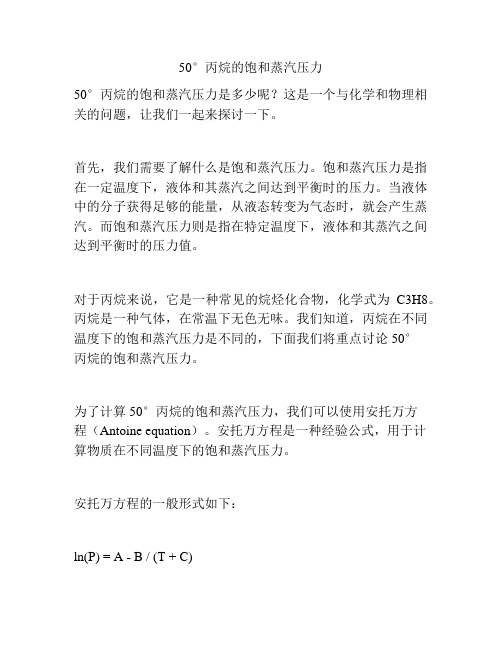
50°丙烷的饱和蒸汽压力50°丙烷的饱和蒸汽压力是多少呢?这是一个与化学和物理相关的问题,让我们一起来探讨一下。
首先,我们需要了解什么是饱和蒸汽压力。
饱和蒸汽压力是指在一定温度下,液体和其蒸汽之间达到平衡时的压力。
当液体中的分子获得足够的能量,从液态转变为气态时,就会产生蒸汽。
而饱和蒸汽压力则是指在特定温度下,液体和其蒸汽之间达到平衡时的压力值。
对于丙烷来说,它是一种常见的烷烃化合物,化学式为C3H8。
丙烷是一种气体,在常温下无色无味。
我们知道,丙烷在不同温度下的饱和蒸汽压力是不同的,下面我们将重点讨论50°丙烷的饱和蒸汽压力。
为了计算50°丙烷的饱和蒸汽压力,我们可以使用安托万方程(Antoine equation)。
安托万方程是一种经验公式,用于计算物质在不同温度下的饱和蒸汽压力。
安托万方程的一般形式如下:ln(P) = A - B / (T + C)其中,P表示饱和蒸汽压力(单位为mmHg),T表示温度(单位为摄氏度),A、B、C为实验常数。
对于丙烷来说,根据实验数据得到的安托万方程参数如下:A = 4.00977B = 1135.49C = -53.67将温度T替换为50°摄氏度,我们可以计算出50°丙烷的饱和蒸汽压力P。
ln(P) = 4.00977 - 1135.49 / (50 - 53.67)解方程可得:ln(P) = 4.00977 + 1135.49 / (53.67 - 50)由于ln(P)与P之间是对数关系,我们可以通过反对数运算得到P的值:P = e^(4.00977 + 1135.49 / (53.67 - 50))通过计算可得50°丙烷的饱和蒸汽压力约为X mmHg(具体数值请根据计算结果进行填写)。
总结一下,50°丙烷的饱和蒸汽压力可以通过安托万方程来计算。
根据实验数据,我们可以得到丙烷的安托万方程参数,并通过代入温度值计算出50°丙烷的饱和蒸汽压力。
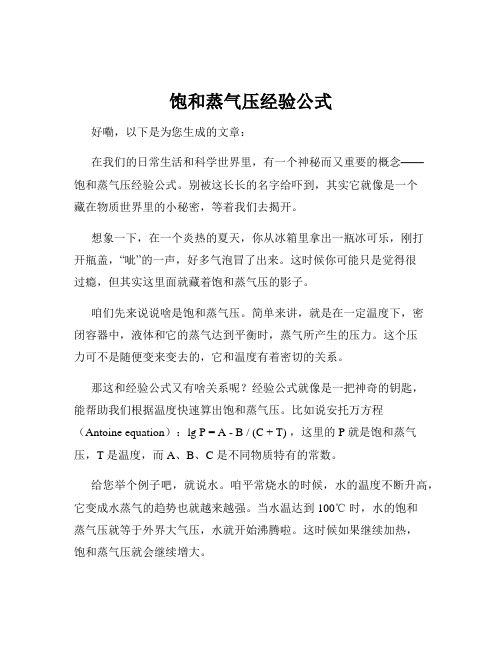
饱和蒸气压经验公式好嘞,以下是为您生成的文章:在我们的日常生活和科学世界里,有一个神秘而又重要的概念——饱和蒸气压经验公式。
别被这长长的名字给吓到,其实它就像是一个藏在物质世界里的小秘密,等着我们去揭开。
想象一下,在一个炎热的夏天,你从冰箱里拿出一瓶冰可乐,刚打开瓶盖,“呲”的一声,好多气泡冒了出来。
这时候你可能只是觉得很过瘾,但其实这里面就藏着饱和蒸气压的影子。
咱们先来说说啥是饱和蒸气压。
简单来讲,就是在一定温度下,密闭容器中,液体和它的蒸气达到平衡时,蒸气所产生的压力。
这个压力可不是随便变来变去的,它和温度有着密切的关系。
那这和经验公式又有啥关系呢?经验公式就像是一把神奇的钥匙,能帮助我们根据温度快速算出饱和蒸气压。
比如说安托万方程(Antoine equation):lg P = A - B / (C + T) ,这里的 P 就是饱和蒸气压,T 是温度,而 A、B、C 是不同物质特有的常数。
给您举个例子吧,就说水。
咱平常烧水的时候,水的温度不断升高,它变成水蒸气的趋势也就越来越强。
当水温达到 100℃时,水的饱和蒸气压就等于外界大气压,水就开始沸腾啦。
这时候如果继续加热,饱和蒸气压就会继续增大。
还记得有一次我在实验室做实验,研究不同温度下某种液体的饱和蒸气压。
那真是个精细又有趣的过程。
我小心翼翼地控制着温度,眼睛紧紧盯着压力计,每一个细微的变化都不敢错过。
当温度升高一点点,压力计的指针就会轻轻跳动一下,就好像在跟我悄悄地说话,告诉我物质的秘密。
在工业生产中,饱和蒸气压经验公式也发挥着大作用。
比如化工生产中,要控制反应的条件,就得知道各种物质在不同温度下的饱和蒸气压,这样才能保证生产的安全和高效。
再比如在气象学里,研究大气中的水汽含量和分布,也离不开对饱和蒸气压的了解。
不然怎么能准确预测天气呢?总之,饱和蒸气压经验公式虽然听起来有点复杂,但它其实就在我们身边,影响着我们生活的方方面面。
从一瓶冰可乐到工业生产,从实验室的研究到天气预报,它就像一个默默无闻的小英雄,发挥着重要的作用。
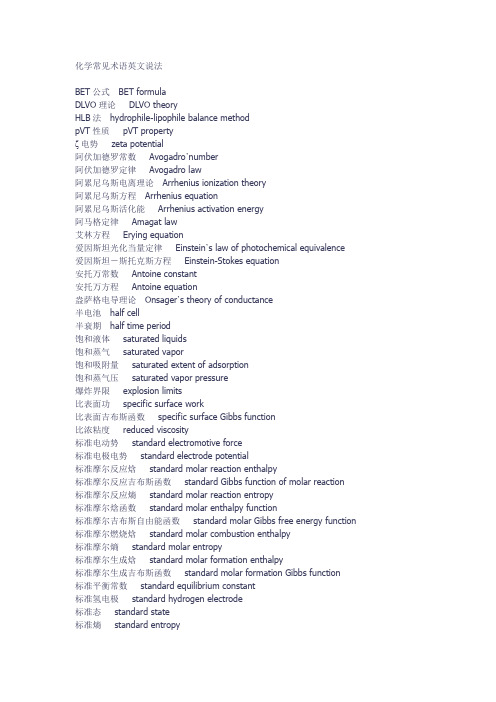
化学常见术语英文说法BET公式BET formulaDLVO理论DLVO theoryHLB法hydrophile-lipophile balance methodpVT性质pVT propertyζ电势zeta potential阿伏加德罗常数Avogadro’number阿伏加德罗定律Avogadro law阿累尼乌斯电离理论Arrhenius ionization theory阿累尼乌斯方程Arrhenius equation阿累尼乌斯活化能Arrhenius activation energy阿马格定律Amagat law艾林方程Erying equation爱因斯坦光化当量定律Einstein’s law of photochemical equivalence爱因斯坦-斯托克斯方程Einstein-Stokes equation安托万常数Antoine constant安托万方程Antoine equation盎萨格电导理论Onsager’s theory of conductance半电池half cell半衰期half time period饱和液体saturated liquids饱和蒸气saturated vapor饱和吸附量saturated extent of adsorption饱和蒸气压saturated vapor pressure爆炸界限explosion limits比表面功specific surface work比表面吉布斯函数specific surface Gibbs function比浓粘度reduced viscosity标准电动势standard electromotive force标准电极电势standard electrode potential标准摩尔反应焓standard molar reaction enthalpy标准摩尔反应吉布斯函数standard Gibbs function of molar reaction标准摩尔反应熵standard molar reaction entropy标准摩尔焓函数standard molar enthalpy function标准摩尔吉布斯自由能函数standard molar Gibbs free energy function 标准摩尔燃烧焓standard molar combustion enthalpy标准摩尔熵standard molar entropy标准摩尔生成焓standard molar formation enthalpy标准摩尔生成吉布斯函数standard molar formation Gibbs function标准平衡常数standard equilibrium constant标准氢电极standard hydrogen electrode标准态standard state标准熵standard entropy标准压力standard pressure标准状况standard condition表观活化能apparent activation energy表观摩尔质量apparent molecular weight表观迁移数apparent transference number表面surfaces表面过程控制surface process control表面活性剂surfactants表面吸附量surface excess表面张力surface tension表面质量作用定律surface mass action law波义尔定律Boyle law波义尔温度Boyle temperature波义尔点Boyle point玻尔兹曼常数Boltzmann constant玻尔兹曼分布Boltzmann distribution玻尔兹曼公式Boltzmann formula玻尔兹曼熵定理Boltzmann entropy theorem玻色-爱因斯坦统计Bose-Einstein statistics泊Poise不可逆过程irreversible process不可逆过程热力学thermodynamics of irreversible processes 不可逆相变化irreversible phase change布朗运动brownian movement查理定律Charle’s law产率yield敞开系统open system超电势over potential沉降sedimentation沉降电势sedimentation potential沉降平衡sedimentation equilibrium触变thixotropy粗分散系统thick disperse system催化剂catalyst单分子层吸附理论mono molecule layer adsorption单分子反应unimolecular reaction单链反应straight chain reactions弹式量热计bomb calorimeter道尔顿定律Dalton law道尔顿分压定律Dalton partial pressure law德拜和法尔肯哈根效应Debye and Falkenhagen effect德拜立方公式Debye cubic formula德拜-休克尔极限公式Debye-Huckel’s limiting equation等焓过程isenthalpic process等焓线isenthalpic line等几率定理theorem of equal probability等温等容位Helmholtz free energy等温等压位Gibbs free energy等温方程equation at constant temperature低共熔点eutectic point低共熔混合物eutectic mixture低会溶点lower consolute point低熔冰盐合晶cryohydric第二类永动机perpetual machine of the second kind第三定律熵third-law entropy第一类永动机perpetual machine of the first kind缔合化学吸附association chemical adsorption电池常数cell constant电池电动势electromotive force of cells电池反应cell reaction电导conductance电导率conductivity电动势的温度系数temperature coefficient of electromotive force 电动电势zeta potential电功electric work电化学electrochemistry电化学极化electrochemical polarization电极电势electrode potential电极反应reactions on the electrode电极种类type of electrodes电解池electrolytic cell电量计coulometer电流效率current efficiency电迁移electro migration电迁移率electromobility电渗electroosmosis电渗析electrodialysis电泳electrophoresis丁达尔效应Dyndall effect定容摩尔热容molar heat capacity under constant volume定容温度计Constant voIume thermometer定压摩尔热容molar heat capacity under constant pressure定压温度计constant pressure thermometer定域子系统localized particle system动力学方程kinetic equations动力学控制kinetics control独立子系统independent particle system对比摩尔体积reduced mole volume对比体积reduced volume对比温度reduced temperature对比压力reduced pressure对称数symmetry number对行反应reversible reactions对应状态原理principle of corresponding state多方过程polytropic process多分子层吸附理论adsorption theory of multi-molecular layers 二级反应second order reaction二级相变second order phase change法拉第常数faraday constant法拉第定律Faraday’s law反电动势back E.M.F.反渗透reverse osmosis反应分子数molecularity反应级数reaction orders反应进度extent of reaction反应热heat of reaction反应速率rate of reaction反应速率常数constant of reaction rate范德华常数van der Waals constant范德华方程van der Waals equation范德华力van der Waals force范德华气体van der Waals gases范特霍夫方程van’t Hoff equation范特霍夫规则van’t Hoff rule范特霍夫渗透压公式van’t Hoff equation of osmotic pressure 非基元反应non-elementary reactions非体积功non-volume work非依时计量学反应time independent stoichiometric reactions 菲克扩散第一定律Fick’s first law of diffusion沸点boiling point沸点升高elevation of boiling point费米-狄拉克统计Fermi-Dirac statistics分布distribution分布数distribution numbers分解电压decomposition voltage分配定律distribution law分散系统disperse system分散相dispersion phase分体积partial volume分体积定律partial volume law分压partial pressure分压定律partial pressure law分子反应力学mechanics of molecular reactions分子间力intermolecular force分子蒸馏molecular distillation封闭系统closed system附加压力excess pressure弗罗因德利希吸附经验式Freundlich empirical formula of adsorption 负极negative pole负吸附negative adsorption复合反应composite reaction盖·吕萨克定律Gay-Lussac law盖斯定律Hess law甘汞电极calomel electrode感胶离子序lyotropic series杠杆规则lever rule高分子溶液macromolecular solution高会溶点upper consolute point隔离法the isolation method格罗塞斯-德雷珀定律Grotthus-Draoer’s law隔离系统isolated system根均方速率root-mean-square speed功work功函work content共轭溶液conjugate solution共沸温度azeotropic temperature构型熵configurational entropy孤立系统isolated system固溶胶solid sol固态混合物solid solution固相线solid phase line光反应photoreaction光化学第二定律the second law of actinochemistry光化学第一定律the first law of actinochemistry光敏反应photosensitized reactions光谱熵spectrum entropy广度性质extensive property广延量extensive quantity广延性质extensive property规定熵stipulated entropy过饱和溶液oversaturated solution过饱和蒸气oversaturated vapor过程process过渡状态理论transition state theory过冷水super-cooled water过冷液体overcooled liquid过热液体overheated liquid亥姆霍兹函数Helmholtz function亥姆霍兹函数判据Helmholtz function criterion亥姆霍兹自由能Helmholtz free energy亥氏函数Helmholtz function焓enthalpy亨利常数Henry constant亨利定律Henry law恒沸混合物constant boiling mixture恒容摩尔热容molar heat capacity at constant volume恒容热heat at constant volume恒外压constant external pressure恒压摩尔热容molar heat capacity at constant pressure恒压热heat at constant pressure化学动力学chemical kinetics化学反应计量式stoichiometric equation of chemical reaction化学反应计量系数stoichiometric coefficient of chemical reaction 化学反应进度extent of chemical reaction化学亲合势chemical affinity化学热力学chemical thermodynamics化学势chemical potential化学势判据chemical potential criterion化学吸附chemisorptions环境environment环境熵变entropy change in environment挥发度volatility混合熵entropy of mixing混合物mixture活度activity活化控制activation control活化络合物理论activated complex theory活化能activation energy霍根-华森图Hougen-Watson Chart基态能级energy level at ground state基希霍夫公式Kirchhoff formula基元反应elementary reactions积分溶解热integration heat of dissolution吉布斯-杜亥姆方程Gibbs-Duhem equation吉布斯-亥姆霍兹方程Gibbs-Helmhotz equation吉布斯函数Gibbs function吉布斯函数判据Gibbs function criterion吉布斯吸附公式Gibbs adsorption formula吉布斯自由能Gibbs free energy吉氏函数Gibbs function极化电极电势polarization potential of electrode 极化曲线polarization curves极化作用polarization极限摩尔电导率limiting molar conductivity几率因子steric factor计量式stoichiometric equation计量系数stoichiometric coefficient价数规则rule of valence简并度degeneracy键焓bond enthalpy胶冻broth jelly胶核colloidal nucleus胶凝作用demulsification胶束micelle胶体colloid胶体分散系统dispersion system of colloid胶体化学collochemistry胶体粒子colloidal particles胶团micelle焦耳Joule焦耳-汤姆生实验Joule-Thomson experiment焦耳-汤姆生系数Joule-Thomson coefficient焦耳-汤姆生效应Joule-Thomson effect焦耳定律Joule's law接触电势contact potential接触角contact angle节流过程throttling process节流膨胀throttling expansion节流膨胀系数coefficient of throttling expansion 结线tie line结晶热heat of crystallization解离化学吸附dissociation chemical adsorption 界面interfaces界面张力surface tension浸湿immersion wetting浸湿功immersion wetting work精馏rectify聚(合)电解质polyelectrolyte聚沉coagulation聚沉值coagulation value绝对反应速率理论absolute reaction rate theory 绝对熵absolute entropy绝对温标absolute temperature scale绝热过程adiabatic process绝热量热计adiabatic calorimeter绝热指数adiabatic index卡诺定理Carnot theorem卡诺循环Carnot cycle开尔文公式Kelvin formula柯诺瓦洛夫-吉布斯定律Konovalov-Gibbs law科尔劳施离子独立运动定律Kohlrausch’s Law of Independent Migration of Ions可能的电解质potential electrolyte可逆电池reversible cell可逆过程reversible process可逆过程方程reversible process equation可逆体积功reversible volume work可逆相变reversible phase change克拉佩龙方程Clapeyron equation克劳修斯不等式Clausius inequality克劳修斯-克拉佩龙方程Clausius-Clapeyron equation控制步骤control step库仑计coulometer扩散控制diffusion controlled拉普拉斯方程Laplace’s equation拉乌尔定律Raoult law兰格缪尔-欣谢尔伍德机理Langmuir-Hinshelwood mechanism兰格缪尔吸附等温式Langmuir adsorption isotherm formula雷利公式Rayleigh equation冷冻系数coefficient of refrigeration冷却曲线cooling curve离解热heat of dissociation离解压力dissociation pressure离域子系统non-localized particle systems离子的标准摩尔生成焓standard molar formation of ion离子的电迁移率mobility of ions离子的迁移数transport number of ions离子独立运动定律law of the independent migration of ions离子氛ionic atmosphere离子强度ionic strength理想混合物perfect mixture理想气体ideal gas理想气体的绝热指数adiabatic index of ideal gases理想气体的微观模型micro-model of ideal gas理想气体反应的等温方程isothermal equation of ideal gaseous reactions理想气体绝热可逆过程方程adiabatic reversible process equation of ideal gases理想气体状态方程state equation of ideal gas理想稀溶液ideal dilute solution理想液态混合物perfect liquid mixture粒子particles粒子的配分函数partition function of particles连串反应consecutive reactions链的传递物chain carrier链反应chain reactions量热熵calorimetric entropy量子统计quantum statistics量子效率quantum yield临界参数critical parameter临界常数critical constant临界点critical point临界胶束浓度critical micelle concentration临界摩尔体积critical molar volume临界温度critical temperature临界压力critical pressure临界状态critical state零级反应zero order reaction流动电势streaming potential流动功flow work笼罩效应cage effect路易斯-兰德尔逸度规则Lewis-Randall rule of fugacity 露点dew point露点线dew point line麦克斯韦关系式Maxwell relations麦克斯韦速率分布Maxwell distribution of speeds麦克斯韦能量分布MaxwelIdistribution of energy毛细管凝结condensation in capillary毛细现象capillary phenomena米凯利斯常数Michaelis constant摩尔电导率molar conductivity摩尔反应焓molar reaction enthalpy摩尔混合熵mole entropy of mixing摩尔气体常数molar gas constant摩尔热容molar heat capacity摩尔溶解焓mole dissolution enthalpy摩尔稀释焓mole dilution enthalpy内扩散控制internal diffusions control内能internal energy内压力internal pressure能级energy levels能级分布energy level distribution能量均分原理principle of the equipartition of energy能斯特方程Nernst equation能斯特热定理Nernst heat theorem凝固点freezing point凝固点降低lowering of freezing point凝固点曲线freezing point curve凝胶gelatin凝聚态condensed state凝聚相condensed phase浓差超电势concentration over-potential浓差极化concentration polarization浓差电池concentration cells帕斯卡pascal泡点bubble point泡点线bubble point line配分函数partition function配分函数的析因子性质property that partition function to be expressed as a product of the separate partition functions for each kind of state碰撞截面collision cross section碰撞数the number of collisions偏摩尔量partial mole quantities平衡常数(理想气体反应)equilibrium constants for reactions of ideal gases平动配分函数partition function of translation平衡分布equilibrium distribution平衡态equilibrium state平衡态近似法equilibrium state approximation平衡状态图equilibrium state diagram平均活度mean activity平均活度系统mean activity coefficient平均摩尔热容mean molar heat capacity平均质量摩尔浓度mean mass molarity平均自由程mean free path平行反应parallel reactions破乳demulsification铺展spreading普遍化范德华方程universal van der Waals equation其它功the other work气化热heat of vaporization气溶胶aerosol气体常数gas constant气体分子运动论kinetic theory of gases气体分子运动论的基本方程foundamental equation of kinetic theory of gases 气溶胶aerosol气相线vapor line迁移数transport number潜热latent heat强度量intensive quantity强度性质intensive property亲液溶胶hydrophilic sol氢电极hydrogen electrodes区域熔化zone melting热heat热爆炸heat explosion热泵heat pump热功当量mechanical equivalent of heat热函heat content热化学thermochemistry热化学方程thermochemical equation热机heat engine热机效率efficiency of heat engine热力学thermodynamics热力学第二定律the second law of thermodynamics热力学第三定律the third law of thermodynamics热力学第一定律the first law of thermodynamics热力学基本方程fundamental equation of thermodynamics热力学几率thermodynamic probability热力学能thermodynamic energy热力学特性函数characteristic thermodynamic function热力学温标thermodynamic scale of temperature热力学温度thermodynamic temperature热熵thermal entropy热效应heat effect熔点曲线melting point curve熔化热heat of fusion溶胶colloidal sol溶解焓dissolution enthalpy溶液solution溶胀swelling乳化剂emulsifier乳状液emulsion润湿wetting润湿角wetting angle萨克尔-泰特洛德方程Sackur-Tetrode equation三相点triple point三相平衡线triple-phase line熵entropy熵判据entropy criterion熵增原理principle of entropy increase渗透压osmotic pressure渗析法dialytic process生成反应formation reaction升华热heat of sublimation实际气体real gas舒尔采-哈迪规则Schulze-Hardy rule松驰力relaxation force松驰时间time of relaxation速度常数reaction rate constant速率方程rate equations速率控制步骤rate determining step塔费尔公式Tafel equation态-态反应state-state reactions唐南平衡Donnan equilibrium淌度mobility特鲁顿规则Trouton rule特性粘度intrinsic viscosity体积功volume work统计权重statistical weight统计热力学statistic thermodynamics统计熵statistic entropy途径path途径函数path function外扩散控制external diffusion control完美晶体perfect crystalline完全气体perfect gas微观状态microstate微态microstate韦斯顿标准电池Weston standard battery维恩效应Wien effect维里方程virial equation维里系数virial coefficient稳流过程steady flow process稳态近似法stationary state approximation无热溶液athermal solution无限稀溶液solutions in the limit of extreme dilution 物理化学Physical Chemistry物理吸附physisorptions吸附adsorption吸附等量线adsorption isostere吸附等温线adsorption isotherm吸附等压线adsorption isobar吸附剂adsorbent吸附量extent of adsorption吸附热heat of adsorption吸附质adsorbate析出电势evolution or deposition potential析因子性质property that partition function to be expressed as a product ofthe separate partition functions for each kind of state稀溶液的依数性colligative properties of dilute solutions稀释焓dilution enthalpy系统system系统点system point系统的环境environment of system相phase相变phase change相变焓enthalpy of phase change相变化phase change相变热heat of phase change相点phase point相对挥发度relative volatility相对粘度relative viscosity相律phase rule相平衡热容heat capacity in phase equilibrium相图phase diagram相倚子系统system of dependent particles悬浮液suspension循环过程cyclic process压力商pressure quotient压缩因子compressibility factor压缩因子图diagram of compressibility factor亚稳状态metastable state盐桥salt bridge盐析salting out阳极anode杨氏方程Young’s equation液体接界电势liquid junction potential液相线liquid phase lines一级反应first order reaction一级相变first order phase change依时计量学反应time dependent stoichiometric reactions逸度fugacity逸度系数coefficient of fugacity阴极cathode荧光fluorescence永动机perpetual motion machine永久气体Permanent gas有效能available energy原电池primary cell原盐效应salt effect增比粘度specific viscosity憎液溶胶lyophobic sol沾湿adhesional wetting沾湿功the work of adhesional wetting真溶液true solution真实电解质real electrolyte真实气体real gas真实迁移数true transference number振动配分函数partition function of vibration振动特征温度characteristic temperature of vibration 蒸气压下降depression of vapor pressure正常沸点normal point正吸附positive adsorption支链反应branched chain reactions直链反应straight chain reactions指前因子pre-exponential factor质量作用定律mass action law制冷系数coefficient of refrigeration中和热heat of neutralization轴功shaft work转动配分函数partition function of rotation转动特征温度characteristic temperature of vibration 转化率convert ratio转化温度conversion temperature状态state状态方程state equation状态分布state distribution状态函数state function准静态过程quasi-static process准一级反应pseudo first order reaction自动催化作用auto-catalysis自由度degree of freedom自由度数number of degree of freedom自由焓free enthalpy自由能free energy自由膨胀free expansion组分数component number最低恒沸点lower azeotropic point最高恒沸点upper azeotropic point最佳反应温度optimal reaction temperature 最可几分布most probable distribution最可几速率most propable speed。
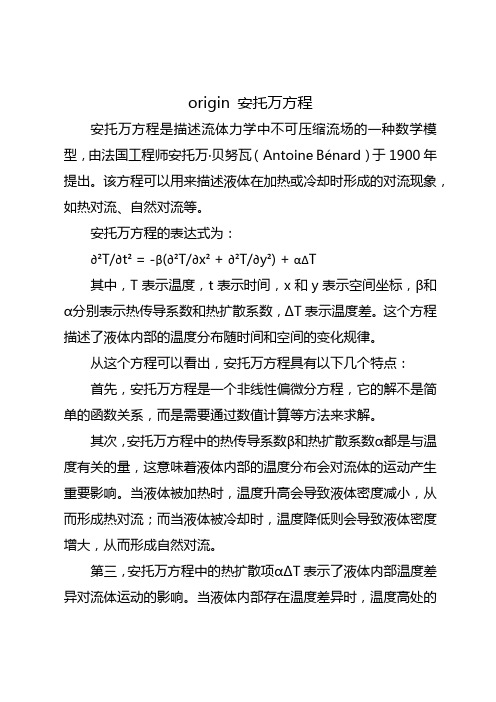
origin 安托万方程安托万方程是描述流体力学中不可压缩流场的一种数学模型,由法国工程师安托万·贝努瓦(Antoine Bénard)于1900年提出。
该方程可以用来描述液体在加热或冷却时形成的对流现象,如热对流、自然对流等。
安托万方程的表达式为:∂²T/∂t² = -β(∂²T/∂x² + ∂²T/∂y²) + αΔT其中,T表示温度,t表示时间,x和y表示空间坐标,β和α分别表示热传导系数和热扩散系数,ΔT表示温度差。
这个方程描述了液体内部的温度分布随时间和空间的变化规律。
从这个方程可以看出,安托万方程具有以下几个特点:首先,安托万方程是一个非线性偏微分方程,它的解不是简单的函数关系,而是需要通过数值计算等方法来求解。
其次,安托万方程中的热传导系数β和热扩散系数α都是与温度有关的量,这意味着液体内部的温度分布会对流体的运动产生重要影响。
当液体被加热时,温度升高会导致液体密度减小,从而形成热对流;而当液体被冷却时,温度降低则会导致液体密度增大,从而形成自然对流。
第三,安托万方程中的热扩散项αΔT表示了液体内部温度差异对流体运动的影响。
当液体内部存在温度差异时,温度高处的流体会向温度低处流动,从而形成一个热对流的区域。
这种热对流又会进一步促进液体内部的热量传递和混合,从而使整个流体系统达到一个稳定的状态。
最后,安托万方程中的非线性项-β(∂²T/∂x² + ∂²T/∂y²)表示了液体内部的温度梯度对流体运动的影响。
当液体内部存在温度梯度时,温度高处的流体会向下流动,而温度低处的流体会向上流动,从而形成一个自然对流的区域。
这种自然对流又会进一步促进液体内部的热量传递和混合,从而使整个流体系统达到一个稳定的状态。
总之,安托万方程是描述流体力学中不可压缩流场的一种数学模型,它可以用来描述液体在加热或冷却时形成的对流现象。
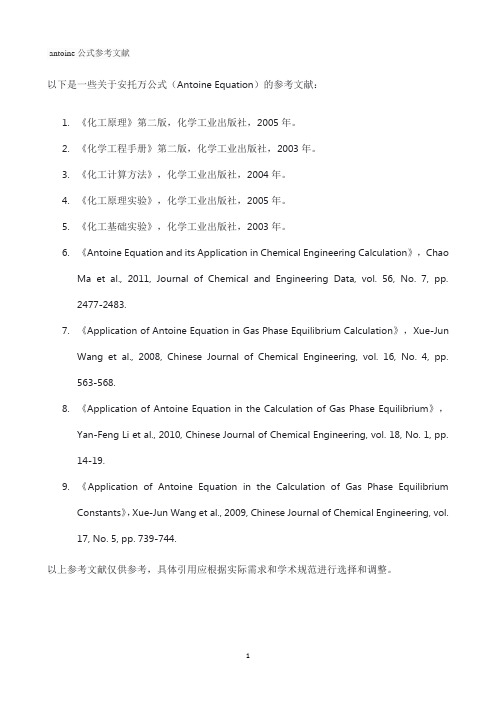
antoine公式参考文献以下是一些关于安托万公式(Antoine Equation)的参考文献:1.《化工原理》第二版,化学工业出版社,2005年。
2.《化学工程手册》第二版,化学工业出版社,2003年。
3.《化工计算方法》,化学工业出版社,2004年。
4.《化工原理实验》,化学工业出版社,2005年。
5.《化工基础实验》,化学工业出版社,2003年。
6.《Antoine Equation and its Application in Chemical Engineering Calculation》,ChaoMa et al., 2011, Journal of Chemical and Engineering Data, vol. 56, No. 7, pp.2477-2483.7.《Application of Antoine Equation in Gas Phase Equilibrium Calculation》,Xue-JunWang et al., 2008, Chinese Journal of Chemical Engineering, vol. 16, No. 4, pp.563-568.8.《Application of Antoine Equation in the Calculation of Gas Phase Equilibrium》,Yan-Feng Li et al., 2010, Chinese Journal of Chemical Engineering, vol. 18, No. 1, pp.14-19.9.《Application of Antoine Equation in the Calculation of Gas Phase EquilibriumConstants》,Xue-Jun Wang et al., 2009, Chinese Journal of Chemical Engineering, vol.17, No. 5, pp. 739-744.以上参考文献仅供参考,具体引用应根据实际需求和学术规范进行选择和调整。
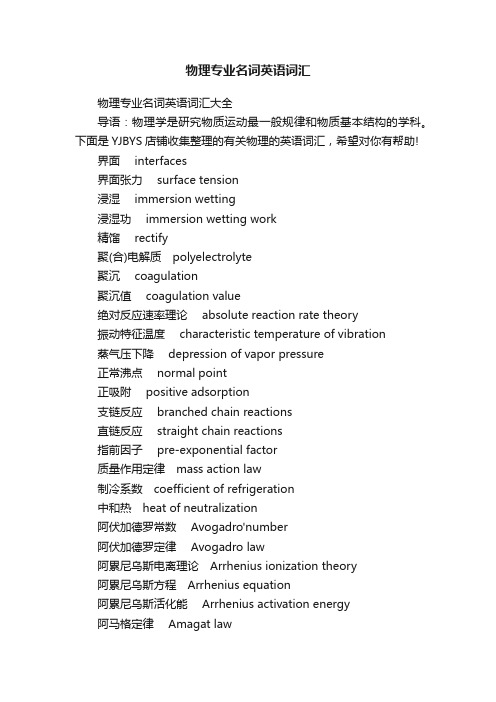
物理专业名词英语词汇物理专业名词英语词汇大全导语:物理学是研究物质运动最一般规律和物质基本结构的学科。
下面是YJBYS店铺收集整理的有关物理的英语词汇,希望对你有帮助!界面 interfaces界面张力 surface tension浸湿 immersion wetting浸湿功 immersion wetting work精馏 rectify聚(合)电解质polyelectrolyte聚沉 coagulation聚沉值 coagulation value绝对反应速率理论 absolute reaction rate theory振动特征温度 characteristic temperature of vibration蒸气压下降 depression of vapor pressure正常沸点 normal point正吸附 positive adsorption支链反应 branched chain reactions直链反应 straight chain reactions指前因子 pre-exponential factor质量作用定律mass action law制冷系数coefficient of refrigeration中和热heat of neutralization阿伏加德罗常数 Avogadro'number阿伏加德罗定律 Avogadro law阿累尼乌斯电离理论Arrhenius ionization theory阿累尼乌斯方程Arrhenius equation阿累尼乌斯活化能 Arrhenius activation energy阿马格定律 Amagat law艾林方程 Erying equation爱因斯坦光化当量定律Einstein's law of photochemical equivalence爱因斯坦-斯托克斯方程 Einstein-Stokes equation安托万常数 Antoine constant安托万方程 Antoine equation盎萨格电导理论Onsager's theory of conductance半电池half cell半衰期half time period饱和液体 saturated liquids饱和蒸气 saturated vapor饱和吸附量 saturated extent of adsorption饱和蒸气压 saturated vapor pressure爆炸界限 explosion limits比表面功 specific surface work比表面吉布斯函数 specific surface Gibbs function比浓粘度 reduced viscosity标准电动势 standard electromotive force标准电极电势 standard electrode potential标准摩尔反应焓 standard molar reaction enthalpy标准摩尔反应吉布斯函数 standard Gibbs function of molar reaction标准摩尔反应熵 standard molar reaction entropy标准摩尔焓函数 standard molar enthalpy function标准摩尔吉布斯自由能函数standard molar Gibbs free energy function标准摩尔燃烧焓 standard molar combustion enthalpy标准摩尔熵 standard molar entropy标准摩尔生成焓 standard molar formation enthalpy标准摩尔生成吉布斯函数standard molar formation Gibbsfunction标准平衡常数 standard equilibrium constant标准氢电极 standard hydrogen electrode标准态 standard state标准熵 standard entropy标准压力 standard pressure标准状况 standard condition表观活化能apparent activation energy表观摩尔质量 apparent molecular weight表观迁移数apparent transference number表面 surfaces表面过程控制 surface process control表面活性剂surfactants表面吸附量 surface excess表面张力 surface tension表面质量作用定律 surface mass action law波义尔定律 Boyle law波义尔温度 Boyle temperature波义尔点 Boyle point玻尔兹曼常数 Boltzmann constant玻尔兹曼分布 Boltzmann distribution玻尔兹曼公式 Boltzmann formula玻尔兹曼熵定理 Boltzmann entropy theorem玻色-爱因斯坦统计Bose-Einstein statistics泊Poise不可逆过程 irreversible process不可逆过程热力学thermodynamics of irreversible processes 不可逆相变化 irreversible phase change布朗运动 brownian movement查理定律 Charle's law产率 yield敞开系统 open system超电势 over potential沉降 sedimentation沉降电势 sedimentation potential沉降平衡 sedimentation equilibrium触变 thixotropy粗分散系统 thick disperse system催化剂 catalyst单分子层吸附理论 mono molecule layer adsorption单分子反应 unimolecular reaction单链反应 straight chain reactions弹式量热计 bomb calorimeter道尔顿定律 Dalton law道尔顿分压定律 Dalton partial pressure law德拜和法尔肯哈根效应Debye and Falkenhagen effect 德拜立方公式 Debye cubic formula德拜-休克尔极限公式 Debye-Huckel's limiting equation 等焓过程 isenthalpic process等焓线isenthalpic line等几率定理 theorem of equal probability等温等容位Helmholtz free energy等温等压位Gibbs free energy等温方程 equation at constant temperature低共熔点 eutectic point低共熔混合物 eutectic mixture低会溶点 lower consolute point低熔冰盐合晶 cryohydric第二类永动机 perpetual machine of the second kind 第三定律熵 third-law entropy第一类永动机 perpetual machine of the first kind缔合化学吸附 association chemical adsorption电池常数 cell constant电池电动势 electromotive force of cells电池反应 cell reaction电导 conductance电导率 conductivity电动势的温度系数 temperature coefficient of electromotive force电动电势 zeta potential电功electric work电化学 electrochemistry电化学极化 electrochemical polarization电极电势 electrode potential电极反应 reactions on the electrode电极种类 type of electrodes电解池 electrolytic cell电量计 coulometer电流效率current efficiency电迁移 electro migration电迁移率 electromobility电渗 electroosmosis电渗析 electrodialysis电泳 electrophoresis丁达尔效应 Dyndall effect定容摩尔热容 molar heat capacity under constant volume 定容温度计 Constant voIume thermometer定压摩尔热容 molar heat capacity under constant pressure 定压温度计 constant pressure thermometer定域子系统 localized particle system动力学方程kinetic equations动力学控制 kinetics control独立子系统 independent particle system对比摩尔体积 reduced mole volume对比体积 reduced volume对比温度 reduced temperature对比压力 reduced pressure对称数 symmetry number对行反应reversible reactions对应状态原理 principle of corresponding state多方过程polytropic process多分子层吸附理论adsorption theory of multi-molecular layers二级反应second order reaction二级相变second order phase change法拉第常数 faraday constant法拉第定律 Faraday's law反电动势back E.M.F.反渗透 reverse osmosis反应分子数 molecularity反应级数 reaction orders反应进度 extent of reaction反应热heat of reaction反应速率rate of reaction反应速率常数 constant of reaction rate范德华常数 van der Waals constant范德华方程 van der Waals equation范德华力 van der Waals force范德华气体 van der Waals gases范特霍夫方程 van't Hoff equation范特霍夫规则 van't Hoff rule范特霍夫渗透压公式 van't Hoff equation of osmotic pressure 非基元反应 non-elementary reactions非体积功 non-volume work非依时计量学反应time independent stoichiometric reactions菲克扩散第一定律 Fick's first law of diffusion沸点 boiling point沸点升高 elevation of boiling point费米-狄拉克统计Fermi-Dirac statistics分布 distribution分布数 distribution numbers分解电压 decomposition voltage分配定律 distribution law分散系统 disperse system分散相 dispersion phase分体积 partial volume分体积定律 partial volume law分压 partial pressure分压定律 partial pressure law分子反应力学 mechanics of molecular reactions分子间力 intermolecular force分子蒸馏molecular distillation封闭系统 closed system附加压力 excess pressure弗罗因德利希吸附经验式Freundlich empirical formula of adsorption负极 negative pole负吸附 negative adsorption复合反应composite reaction盖·吕萨克定律 Gay-Lussac law盖斯定律 Hess law甘汞电极 calomel electrode感胶离子序 lyotropic series杠杆规则 lever rule高分子溶液 macromolecular solution高会溶点 upper consolute point隔离法the isolation method格罗塞斯-德雷珀定律 Grotthus-Draoer's law隔离系统 isolated system根均方速率 root-mean-square speed功 work功函work content共轭溶液 conjugate solution共沸温度 azeotropic temperature构型熵configurational entropy孤立系统 isolated system固溶胶 solid sol固态混合物 solid solution固相线 solid phase line光反应 photoreaction光化学第二定律 the second law of actinochemistry 光化学第一定律 the first law of actinochemistry光敏反应 photosensitized reactions光谱熵 spectrum entropy广度性质 extensive property广延量 extensive quantity广延性质 extensive property规定熵 stipulated entropy过饱和溶液 oversaturated solution过饱和蒸气 oversaturated vapor过程 process过渡状态理论 transition state theory过冷水 super-cooled water过冷液体 overcooled liquid过热液体 overheated liquid亥姆霍兹函数 Helmholtz function亥姆霍兹函数判据 Helmholtz function criterion亥姆霍兹自由能 Helmholtz free energy亥氏函数 Helmholtz function焓 enthalpy亨利常数 Henry constant亨利定律 Henry law恒沸混合物 constant boiling mixture恒容摩尔热容 molar heat capacity at constant volume恒容热 heat at constant volume恒外压 constant external pressure恒压摩尔热容 molar heat capacity at constant pressure恒压热 heat at constant pressure化学动力学chemical kinetics化学反应计量式stoichiometric equation of chemical reaction化学反应计量系数stoichiometric coefficient of chemical reaction化学反应进度 extent of chemical reaction化学亲合势 chemical affinity化学热力学chemical thermodynamics化学势 chemical potential化学势判据 chemical potential criterion化学吸附 chemisorptions环境 environment环境熵变 entropy change in environment挥发度volatility混合熵 entropy of mixing混合物 mixture活度 activity活化控制 activation control活化络合物理论 activated complex theory活化能activation energy霍根-华森图 Hougen-Watson Chart基态能级 energy level at ground state基希霍夫公式 Kirchhoff formula基元反应elementary reactions积分溶解热 integration heat of dissolution吉布斯-杜亥姆方程 Gibbs-Duhem equation吉布斯-亥姆霍兹方程 Gibbs-Helmhotz equation 吉布斯函数 Gibbs function吉布斯函数判据 Gibbs function criterion吉布斯吸附公式Gibbs adsorption formula吉布斯自由能 Gibbs free energy吉氏函数 Gibbs function极化电极电势 polarization potential of electrode 极化曲线 polarization curves极化作用 polarization极限摩尔电导率 limiting molar conductivity几率因子 steric factor计量式 stoichiometric equation计量系数 stoichiometric coefficient价数规则 rule of valence简并度 degeneracy键焓bond enthalpy胶冻 broth jelly胶核 colloidal nucleus胶凝作用 demulsification胶束micelle胶体 colloid胶体分散系统 dispersion system of colloid胶体化学 collochemistry胶体粒子 colloidal particles胶团 micelle焦耳Joule焦耳-汤姆生实验 Joule-Thomson experiment焦耳-汤姆生系数 Joule-Thomson coefficient焦耳-汤姆生效应 Joule-Thomson effect焦耳定律 Joule`s law接触电势contact potential接触角 contact angle节流过程 throttling process节流膨胀 throttling expansion节流膨胀系数 coefficient of throttling expansion 结线 tie line结晶热heat of crystallization解离化学吸附 dissociation chemical adsorption 绝对熵 absolute entropy绝对温标absolute temperature scale绝热过程 adiabatic process绝热量热计adiabatic calorimeter绝热指数 adiabatic index卡诺定理 Carnot theorem下载文档。
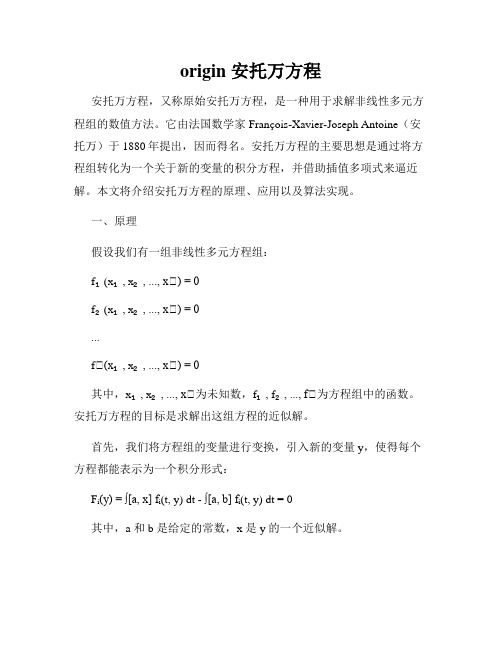
origin 安托万方程安托万方程,又称原始安托万方程,是一种用于求解非线性多元方程组的数值方法。
它由法国数学家François-Xavier-Joseph Antoine(安托万)于1880年提出,因而得名。
安托万方程的主要思想是通过将方程组转化为一个关于新的变量的积分方程,并借助插值多项式来逼近解。
本文将介绍安托万方程的原理、应用以及算法实现。
一、原理假设我们有一组非线性多元方程组:f₁(x₁, x₂, ..., xₙ) = 0f₂(x₁, x₂, ..., xₙ) = 0...fₙ(x₁, x₂, ..., xₙ) = 0其中,x₁, x₂, ..., xₙ为未知数,f₁, f₂, ..., fₙ为方程组中的函数。
安托万方程的目标是求解出这组方程的近似解。
首先,我们将方程组的变量进行变换,引入新的变量 y,使得每个方程都能表示为一个积分形式:Fᵢ(y) = ∫[a, x] fᵢ(t, y) dt - ∫[a, b] fᵢ(t, y) dt = 0其中,a 和 b 是给定的常数,x 是 y 的一个近似解。
接下来,我们使用插值多项式来逼近函数 Fᵢ(y)。
通过选择合适的插值点,我们可以得到一个近似解 y₀,使得 Fᵢ(y₀) ≈ 0。
然后,我们将y₀代入原始方程组,得到一个新的方程组:f₁(x₁, x₂, ..., xₙ, y₀) = 0f₂(x₁, x₂, ..., xₙ, y₀) = 0...fₙ(x₁, x₂, ..., xₙ, y₀) = 0这个方程组可以使用常规的数值方法进行求解,得到原始方程组的近似解。
二、应用安托万方程在实际问题的求解中具有广泛的应用。
它可以用于求解各种非线性多元方程组,例如物理学、工程学和经济学中的方程组。
在物理学中,安托万方程可以用于求解复杂的物理模型。
例如,用于描述流体力学、电磁场和量子力学现象的方程组。
通过将这些方程转化为积分方程,并应用安托万方程的方法,可以得到这些模型的近似解。
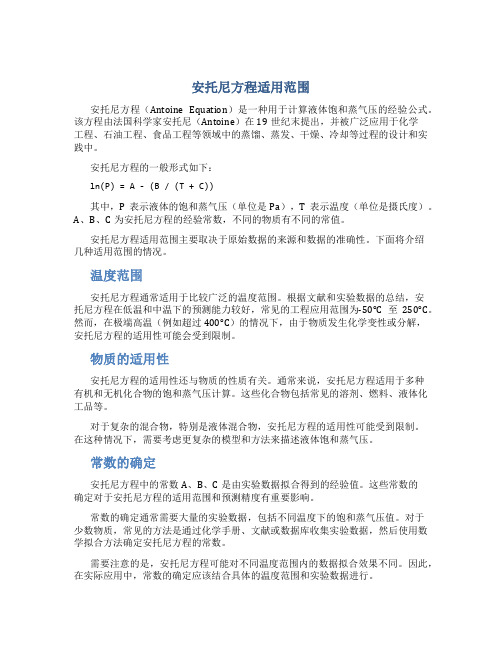
安托尼方程适用范围安托尼方程(Antoine Equation)是一种用于计算液体饱和蒸气压的经验公式。
该方程由法国科学家安托尼(Antoine)在19世纪末提出,并被广泛应用于化学工程、石油工程、食品工程等领域中的蒸馏、蒸发、干燥、冷却等过程的设计和实践中。
安托尼方程的一般形式如下:ln(P) = A - (B / (T + C))其中,P表示液体的饱和蒸气压(单位是Pa),T表示温度(单位是摄氏度)。
A、B、C为安托尼方程的经验常数,不同的物质有不同的常值。
安托尼方程适用范围主要取决于原始数据的来源和数据的准确性。
下面将介绍几种适用范围的情况。
温度范围安托尼方程通常适用于比较广泛的温度范围。
根据文献和实验数据的总结,安托尼方程在低温和中温下的预测能力较好,常见的工程应用范围为-50°C至250°C。
然而,在极端高温(例如超过400°C)的情况下,由于物质发生化学变性或分解,安托尼方程的适用性可能会受到限制。
物质的适用性安托尼方程的适用性还与物质的性质有关。
通常来说,安托尼方程适用于多种有机和无机化合物的饱和蒸气压计算。
这些化合物包括常见的溶剂、燃料、液体化工品等。
对于复杂的混合物,特别是液体混合物,安托尼方程的适用性可能受到限制。
在这种情况下,需要考虑更复杂的模型和方法来描述液体饱和蒸气压。
常数的确定安托尼方程中的常数A、B、C是由实验数据拟合得到的经验值。
这些常数的确定对于安托尼方程的适用范围和预测精度有重要影响。
常数的确定通常需要大量的实验数据,包括不同温度下的饱和蒸气压值。
对于少数物质,常见的方法是通过化学手册、文献或数据库收集实验数据,然后使用数学拟合方法确定安托尼方程的常数。
需要注意的是,安托尼方程可能对不同温度范围内的数据拟合效果不同。
因此,在实际应用中,常数的确定应该结合具体的温度范围和实验数据进行。
结论安托尼方程是一种常见的用于计算液体饱和蒸气压的经验公式。
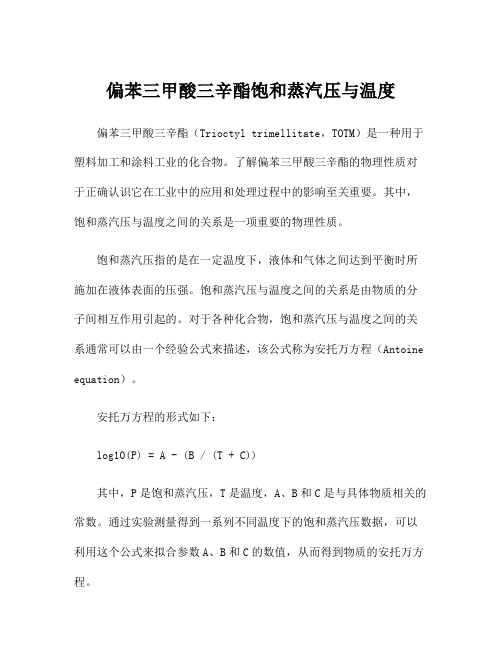
偏苯三甲酸三辛酯饱和蒸汽压与温度偏苯三甲酸三辛酯(Trioctyl trimellitate,TOTM)是一种用于塑料加工和涂料工业的化合物。
了解偏苯三甲酸三辛酯的物理性质对于正确认识它在工业中的应用和处理过程中的影响至关重要。
其中,饱和蒸汽压与温度之间的关系是一项重要的物理性质。
饱和蒸汽压指的是在一定温度下,液体和气体之间达到平衡时所施加在液体表面的压强。
饱和蒸汽压与温度之间的关系是由物质的分子间相互作用引起的。
对于各种化合物,饱和蒸汽压与温度之间的关系通常可以由一个经验公式来描述,该公式称为安托万方程(Antoine equation)。
安托万方程的形式如下:log10(P) = A - (B / (T + C))其中,P是饱和蒸汽压,T是温度,A、B和C是与具体物质相关的常数。
通过实验测量得到一系列不同温度下的饱和蒸汽压数据,可以利用这个公式来拟合参数A、B和C的数值,从而得到物质的安托万方程。
下面我们来看一下偏苯三甲酸三辛酯的饱和蒸汽压与温度之间的关系。
首先,我们需要收集一些实验数据。
根据现有的文献和研究,我们可以找到一些已经测量得到的数据。
以摄氏度(℃)为单位,以下是在不同温度下测得的偏苯三甲酸三辛酯的饱和蒸汽压数据:温度(℃)饱和蒸汽压(Pa)25 6.08 × 10^-750 1.46 × 10^-675 3.68 × 10^-6100 8.52 × 10^-6125 1.88 × 10^-5150 3.95 × 10^-5接下来,我们可以利用这些数据来拟合出偏苯三甲酸三辛酯的安托万方程。
借助公式log10(P) = A - (B / (T + C)),我们可以将每一组温度和饱和蒸汽压的值代入,从而得到相应的方程。
通过拟合,我们可以计算出对应的参数A、B和C。
通过计算,我得到了偏苯三甲酸三辛酯的安托万方程为:log10(P) = 7.5663 - (1616.2 / (T + 195.24))其中,P是饱和蒸汽压(单位:Pa),T是温度(单位:℃)。
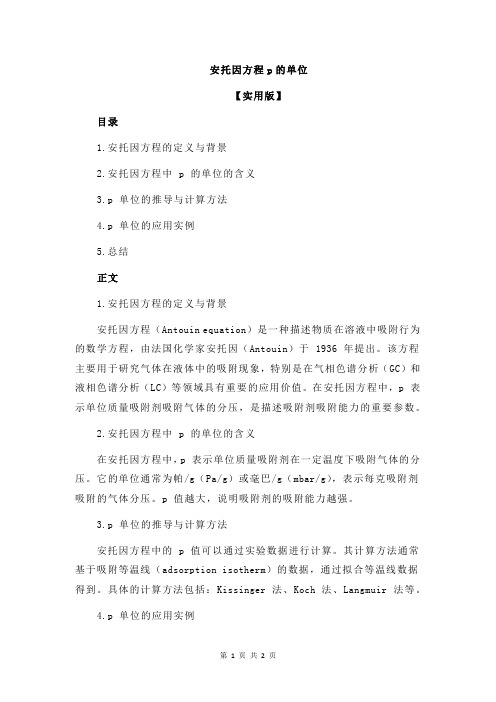
安托因方程p的单位【实用版】目录1.安托因方程的定义与背景2.安托因方程中 p 的单位的含义3.p 单位的推导与计算方法4.p 单位的应用实例5.总结正文1.安托因方程的定义与背景安托因方程(Antouin equation)是一种描述物质在溶液中吸附行为的数学方程,由法国化学家安托因(Antouin)于 1936 年提出。
该方程主要用于研究气体在液体中的吸附现象,特别是在气相色谱分析(GC)和液相色谱分析(LC)等领域具有重要的应用价值。
在安托因方程中,p 表示单位质量吸附剂吸附气体的分压,是描述吸附剂吸附能力的重要参数。
2.安托因方程中 p 的单位的含义在安托因方程中,p 表示单位质量吸附剂在一定温度下吸附气体的分压。
它的单位通常为帕/g(Pa/g)或毫巴/g(mbar/g),表示每克吸附剂吸附的气体分压。
p 值越大,说明吸附剂的吸附能力越强。
3.p 单位的推导与计算方法安托因方程中的 p 值可以通过实验数据进行计算。
其计算方法通常基于吸附等温线(adsorption isotherm)的数据,通过拟合等温线数据得到。
具体的计算方法包括:Kissinger 法、Koch 法、Langmuir 法等。
4.p 单位的应用实例在气相色谱分析(GC)和液相色谱分析(LC)中,p 值被广泛应用于评价吸附剂的性能。
例如,在 GC 分析中,p 值用于描述样品在固定相(吸附剂)和移动相(载气)之间的分配系数,从而影响样品的保留时间。
在LC 分析中,p 值用于描述样品在液相和固相(吸附剂)之间的分配系数,从而影响样品的保留值。
5.总结安托因方程中的 p 值是描述吸附剂吸附能力的重要参数,其单位通常为帕/g 或毫巴/g。
通过实验数据计算得到的 p 值可以应用于气相色谱分析和液相色谱分析等领域,评价吸附剂的性能。
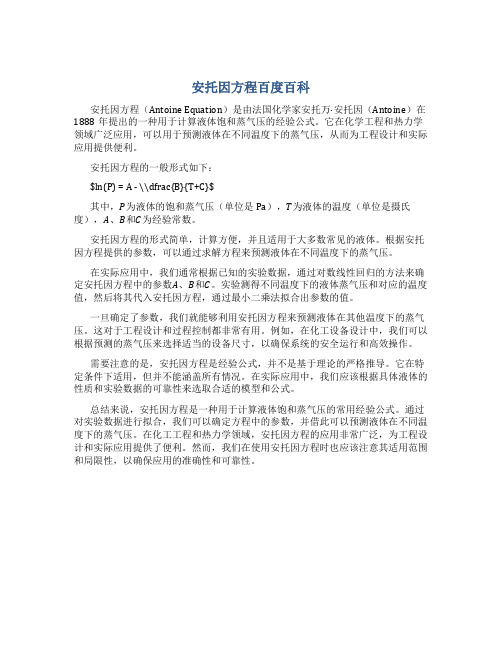
安托因方程百度百科安托因方程(Antoine Equation)是由法国化学家安托万·安托因(Antoine)在1888年提出的一种用于计算液体饱和蒸气压的经验公式。
它在化学工程和热力学领域广泛应用,可以用于预测液体在不同温度下的蒸气压,从而为工程设计和实际应用提供便利。
安托因方程的一般形式如下:$ln(P) = A - \\dfrac{B}{T+C}$其中,P为液体的饱和蒸气压(单位是Pa),T为液体的温度(单位是摄氏度),A、B和C为经验常数。
安托因方程的形式简单,计算方便,并且适用于大多数常见的液体。
根据安托因方程提供的参数,可以通过求解方程来预测液体在不同温度下的蒸气压。
在实际应用中,我们通常根据已知的实验数据,通过对数线性回归的方法来确定安托因方程中的参数A、B和C。
实验测得不同温度下的液体蒸气压和对应的温度值,然后将其代入安托因方程,通过最小二乘法拟合出参数的值。
一旦确定了参数,我们就能够利用安托因方程来预测液体在其他温度下的蒸气压。
这对于工程设计和过程控制都非常有用。
例如,在化工设备设计中,我们可以根据预测的蒸气压来选择适当的设备尺寸,以确保系统的安全运行和高效操作。
需要注意的是,安托因方程是经验公式,并不是基于理论的严格推导。
它在特定条件下适用,但并不能涵盖所有情况。
在实际应用中,我们应该根据具体液体的性质和实验数据的可靠性来选取合适的模型和公式。
总结来说,安托因方程是一种用于计算液体饱和蒸气压的常用经验公式。
通过对实验数据进行拟合,我们可以确定方程中的参数,并借此可以预测液体在不同温度下的蒸气压。
在化工工程和热力学领域,安托因方程的应用非常广泛,为工程设计和实际应用提供了便利。
然而,我们在使用安托因方程时也应该注意其适用范围和局限性,以确保应用的准确性和可靠性。
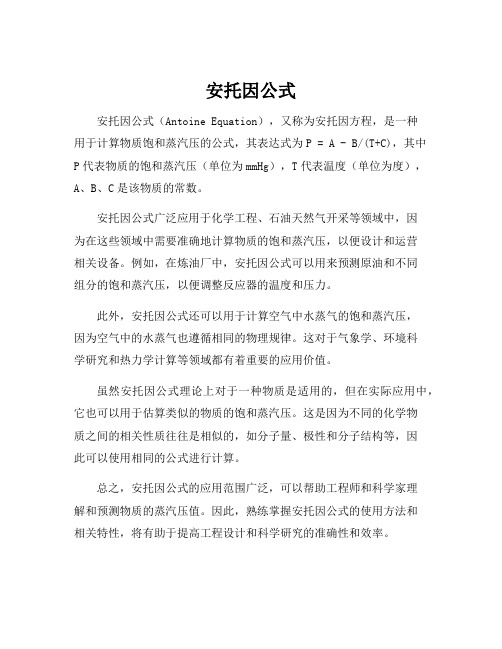
安托因公式
安托因公式(Antoine Equation),又称为安托因方程,是一种
用于计算物质饱和蒸汽压的公式,其表达式为P = A - B/(T+C),其中
P代表物质的饱和蒸汽压(单位为mmHg),T代表温度(单位为度),A、B、C是该物质的常数。
安托因公式广泛应用于化学工程、石油天然气开采等领域中,因
为在这些领域中需要准确地计算物质的饱和蒸汽压,以便设计和运营
相关设备。
例如,在炼油厂中,安托因公式可以用来预测原油和不同
组分的饱和蒸汽压,以便调整反应器的温度和压力。
此外,安托因公式还可以用于计算空气中水蒸气的饱和蒸汽压,
因为空气中的水蒸气也遵循相同的物理规律。
这对于气象学、环境科
学研究和热力学计算等领域都有着重要的应用价值。
虽然安托因公式理论上对于一种物质是适用的,但在实际应用中,它也可以用于估算类似的物质的饱和蒸汽压。
这是因为不同的化学物
质之间的相关性质往往是相似的,如分子量、极性和分子结构等,因
此可以使用相同的公式进行计算。
总之,安托因公式的应用范围广泛,可以帮助工程师和科学家理
解和预测物质的蒸汽压值。
因此,熟练掌握安托因公式的使用方法和
相关特性,将有助于提高工程设计和科学研究的准确性和效率。
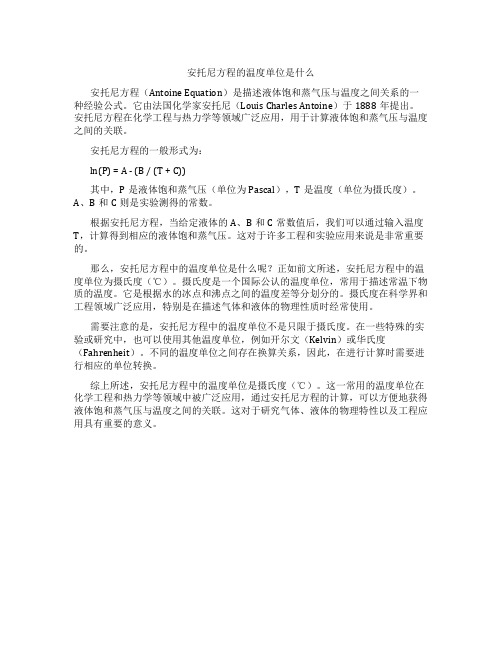
安托尼方程的温度单位是什么
安托尼方程(Antoine Equation)是描述液体饱和蒸气压与温度之间关系的一种经验公式。
它由法国化学家安托尼(Louis Charles Antoine)于1888年提出。
安托尼方程在化学工程与热力学等领域广泛应用,用于计算液体饱和蒸气压与温度之间的关联。
安托尼方程的一般形式为:
ln(P) = A - (B / (T + C))
其中,P是液体饱和蒸气压(单位为Pascal),T是温度(单位为摄氏度)。
A、B和C则是实验测得的常数。
根据安托尼方程,当给定液体的A、B和C常数值后,我们可以通过输入温度T,计算得到相应的液体饱和蒸气压。
这对于许多工程和实验应用来说是非常重要的。
那么,安托尼方程中的温度单位是什么呢?正如前文所述,安托尼方程中的温度单位为摄氏度(℃)。
摄氏度是一个国际公认的温度单位,常用于描述常温下物质的温度。
它是根据水的冰点和沸点之间的温度差等分划分的。
摄氏度在科学界和工程领域广泛应用,特别是在描述气体和液体的物理性质时经常使用。
需要注意的是,安托尼方程中的温度单位不是只限于摄氏度。
在一些特殊的实验或研究中,也可以使用其他温度单位,例如开尔文(Kelvin)或华氏度(Fahrenheit)。
不同的温度单位之间存在换算关系,因此,在进行计算时需要进行相应的单位转换。
综上所述,安托尼方程中的温度单位是摄氏度(℃)。
这一常用的温度单位在化学工程和热力学等领域中被广泛应用,通过安托尼方程的计算,可以方便地获得液体饱和蒸气压与温度之间的关联。
这对于研究气体、液体的物理特性以及工程应用具有重要的意义。
与液体处于动态平衡的蒸汽叫做饱和汽,一定温度下,饱和汽的压强恒定,称为饱和蒸气压。
相对蒸气压=气体的实际气压/同温下气体的饱和气压。
常数系数系列第一弹——最全的安托因方程和常数表(Antoine equation and coefficient)2010年07月16日星期五 07:59 P.M.
大家上面看到的这段公式相信有些人一定很熟悉吧!这是安托因方程的最初版本,发表于1888年,今天要给大家的是安托因方程的常数表,希望对需要的朋友有点用,一共700个化合物,当然还有个版本是4000个庞然大物,我会以excel的形式给大家,这里面提供了5
因子的安托因方程和常数。
对科学没兴趣的绕道吧!以后我会定期更新一些重要的常数信息,当然我估计我这里的是最全的了,除非是专业的数据库,不信的话你去别处看看谁的文章里会有4000个之多的化合物。
(*^__^*) 嘻嘻……
安托万方程(Antoine equation)是工程上广泛使用与实验数据吻合较好的经验方程,是一个最简单的三参数蒸汽压方程,其一般形式为log P = A - B / t +C,其中:P 单位为 mmHg, t 单位为℃, A = 6.91210, B = 1214.645, C = 221.205。
A、B、C是与物质相关的特性常数,使用该方程要注意温度适用范围。
适用的温度范围相当于饱和蒸气压范围为1.5~
200kPa,一般不宜外推。
蒸气压方程中,蒸气压仅是温度的单变量函数,因而只适用于不存在表面张力、流体静压力、重力和电磁场等的影响时。
一般在化工计算中,上述影响可不考虑。
但当液体表面曲率不容忽略时(如蒸气冷凝形成液滴时),就要考虑表面张力的影响。
当流体静压力较大时(如液面有高压惰性气体作用时),也要考虑压力的影响。